スタインウエイが 1872年に取得した特許で デュープレックス機構というのがあります。
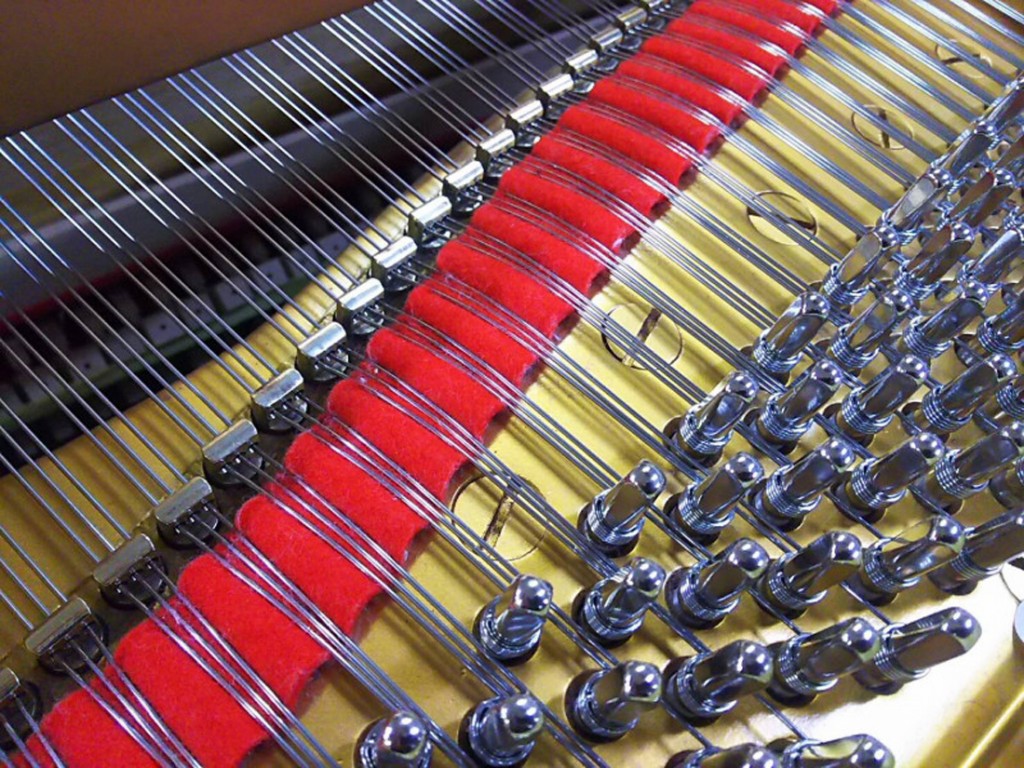
スタインウエイの アグラフとチューニングピン
これは ‥ ピアノの響には 打弦された弦が自由に振動する範囲の前後外側部分にあるアグラフや チューニングピン位置などの条件が影響していることに着目し、それを 積極的に利用するものでした。
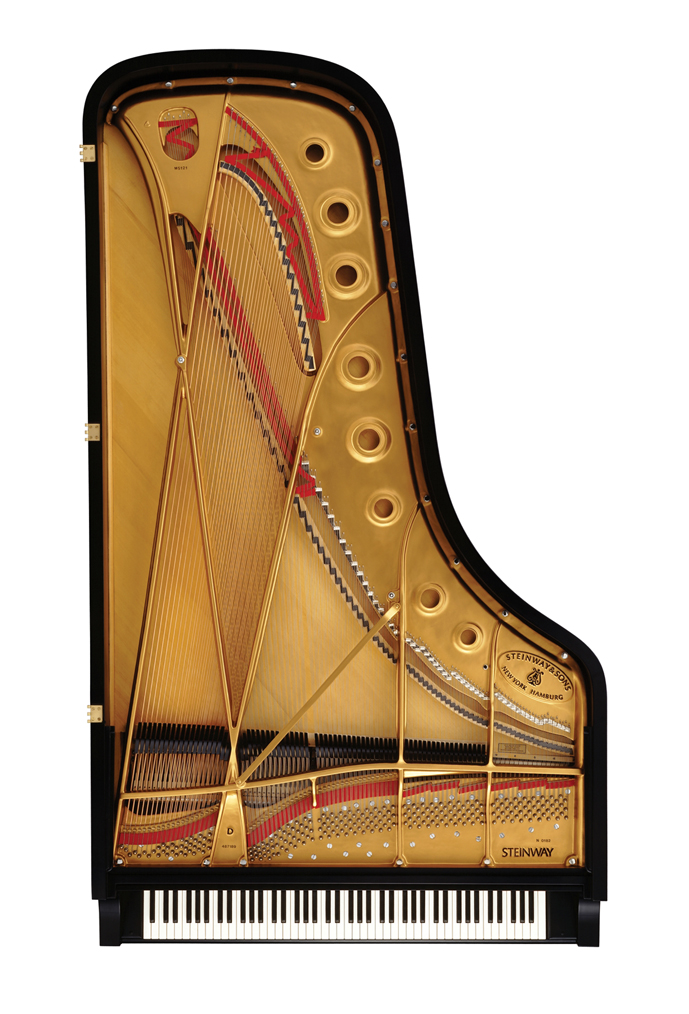
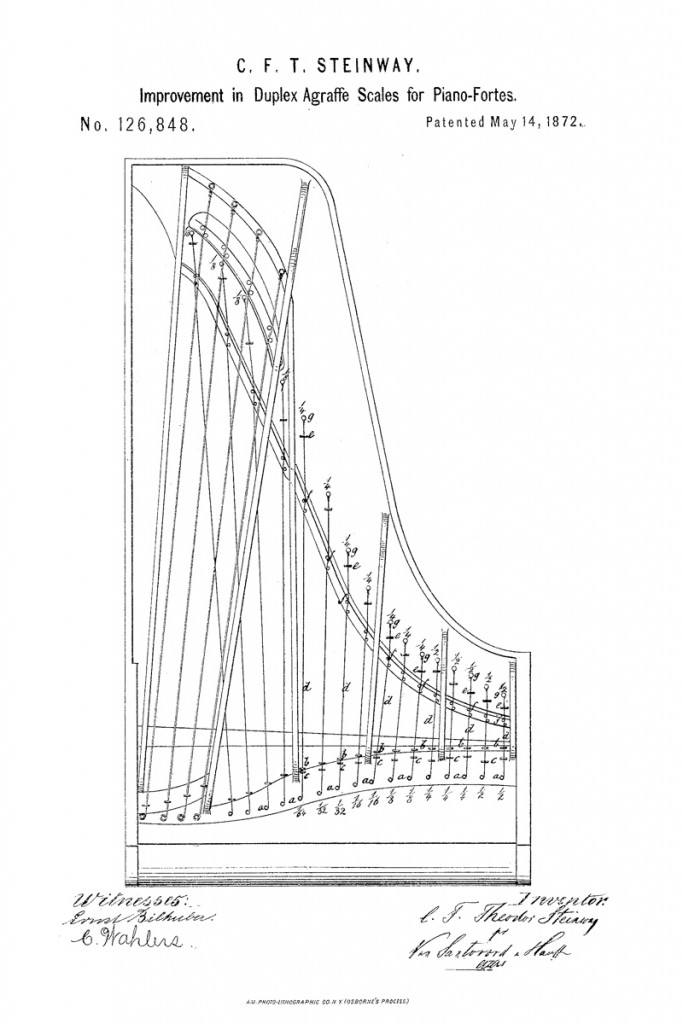
| 公告番号 | US126848 A |
| 公開タイプ | 認定 |
| 公開日 | 1872年5月14日 |
| 公告番号 | US 126848 A, US 126848A, US-A-126848, US126848 A, US126848A |
| 発明者 | C. F. Theodor Stedtway |
IMPROVEMENT IN DUPLEX AGRAFFE SCALES FOR PIANO-FORTES.
UNInn STATES’ PATENT OFFICE.
G. F. THEODOR STEINWAY, 0F NEW YORK, N. Y., ASSIGNOR TO HIMSELF, .elli-BART STEINVAY, AND WILLIAM STEINWAY.
Speciiication forming part of Letters Patent No. 126,943, dated May 14, 187
To all whom it may concern:
Be it known that I, (l. I?. Trinonon S’rnnt WAY, of the city, county, and State of New York, have invented anew and Improved Duplex Agrai’e Scale for Piano-Fortes; and I do hereby declare the following to be a full, clear, and exact description thereof, which will enable those skilled in the art to make and use the saine, reference being had to the aecompanying drawing forming part ot this specification, which drawing represents a plan of a grand piano-forte with my improved scale.
My invention consists in brin ging the vibrations of that portion or’ the string which is situated between the agrade and the tuningpin, in proportion to those ot’ the main portion of the string, in such a manner that the tone produced by said a gratie section is brought in harmony with that of the main section, and thereby the purity and fullness of the tone of the instrument is materially increased, also,4
in bringing the longitudinal vibrations of that portion ot’ the string which is situated between the sounding-board bridge and the hitch-pin in proportion to the vibrations of the main section of the string, so that the sounds due to these longitudinal vibrations are brought in harmony with the tone ot the main section of the string, and the purity and fullness of the tone of the instrument is improved.
In order to enable others to understand my invention, I will here remark that the term scale77 of a piano-torte comprises the position of the strings side by side or above each other, their length and thickness and their tension; and my improvement is applicable to all stringed instruments in which the sounds are produced by the action ol hammers.
If the bass tones of a stringed hammer instrument are sounded -irom octave to octave toward the trcblea great diiierence appears in the effect of the various strings, according to their length, as far as the partial tones of the strings are concerned, which are duc to the spontaneous subdivisions of said strings in halves, quarters, eighths, sikteenths, 85o. rl’he longest duration ofthe vibrations and the highest quality’ to subdivide in partial tones is found in the strings between the contra C and the small c. Within these limits each string subdivides itseli` by the blows of the hammer and by the transverse vibrations due to the same in a large number of nodes whereby the so-called harmonic overtones are produced, and whereby the fundamental tone is rendered rich and brilliant. At the same time this portion of the strings, particularly, produces, by the longitudinal vibrations, a number of unharmonic side tones, making a whistling sound, which disturbs the purity of the tone. Both these qualities disappear as the height of the tone increases, so that the limit of producing a pure fundamental tone is found at a4, while it is in most cases desirable to obtain a clear tone from c5,- but the inherent firmness of the thick strings generally employed, and the great tension required on account of thickness prevents the string ot’ the above-named o5 to make the proper transverse vibrations due to the fundamental tone, and a division into partial tones is out of thc question. In order to eft’ect or promote the subdivision of the string and to produce the desired partial tones, I combine with that portion of the string which is situated between the tuning-pin a (see drawing) and the main agrafte b a secondary agratt’e, c, which supports the string and is placed at a distance from the main agrae corresponding to one of the above-named subdivisions of the main section d oi’ the stringthat is to say, at a distance equal to l, l, 15, or of the length of the main section, or to any combination ot’ these fractions. The main agrafte Z), which supports the string only at one point, allows the transverse vibrations to extend to that part of the string between the said agrafte and the tuning-pin, the vibration of this part being in a direction opposite to that of the main section of the string. By inserting the second agrafi’e c at a distance from the main agraffe equal to gf, gg, ,15, 517 or E13 of the length of the main section oi the string, the subdivision of the string into partial vibrations, and the consequent production of harinonic overtones is effected or promoted7 and a clear, strong, and brilliant tone is obtained up to the highest note.
In the drawing I have marked opposite to each tuning-pin the proportion existing between the distance of the two agra’es and the length of the main section of the string.
By allowing the vibration of the strin g to extend beyond the main agraie the durability of the string is materially increased, since by cutting oft` the vibration of the string at this bration of the strings, I avoid by supporting that portion of the string between the sounding-board bridge and the hitch-pin at distances from the outer bridge-pins equal to l, or 51T of the length of the main portion of each string, or kto any combination 0f these fractions. By the sounding-board bridge the continuation of the transverse vibrations must necessarily be interrupted, owing to the width of the bridge supporting the string, whereby these vibrations are ei’ectually stopped; but particularly With strings of’great thickness, as generally used in piano-fortes of recent construction, the longitudinal vibrations ofthe strings .extend to those portions which are situated between the kbridge and the hitchpins; and in order to avoid unharmonic tones due to these longitudinal vibrations I apply between the bridge and the hitch-pin g, under each string, a support, e, at a distance from the outer bridge-pinf, corresponding to T15, 3 1? or of the length of the main section d of the’ string, or to any combination of these fractions.
In the drawing I have marked opposite to each hitch-pin the proportion existing between the distance from the support c to the bridgepin and the length of the main section of the string. By these means the unharmonic tones due to the longitudinal vibrations ofthe strings are converted into harmonious tones, whichl being transmitted through. the bridge to the sounding-board reach the ear and strengthenl and enrich the fundamental vtone of the string, instead of disturbing the purity thereof, as heretofore. The supports c and e may be made of metal, ivory, or any other material capable of resisting the pressure of the string.
What I claim as new, and desire to secure by Letters Patent, is
l. rIhe arrangement, in a piano-forte, of a g series of successive strings, in each of which the vibrations of that portion situated between the agraie and tuning-pin are brought in har- Witnesses W. HAUFF, E. F. KASTENHUBER.
C. F. THEODOR STEINVAY.
私は ヴァイオリンなどの弦楽器もこれとおなじようなものと考えています。例えればサドルが ピアノにある アグラフの役割といったイメージです。
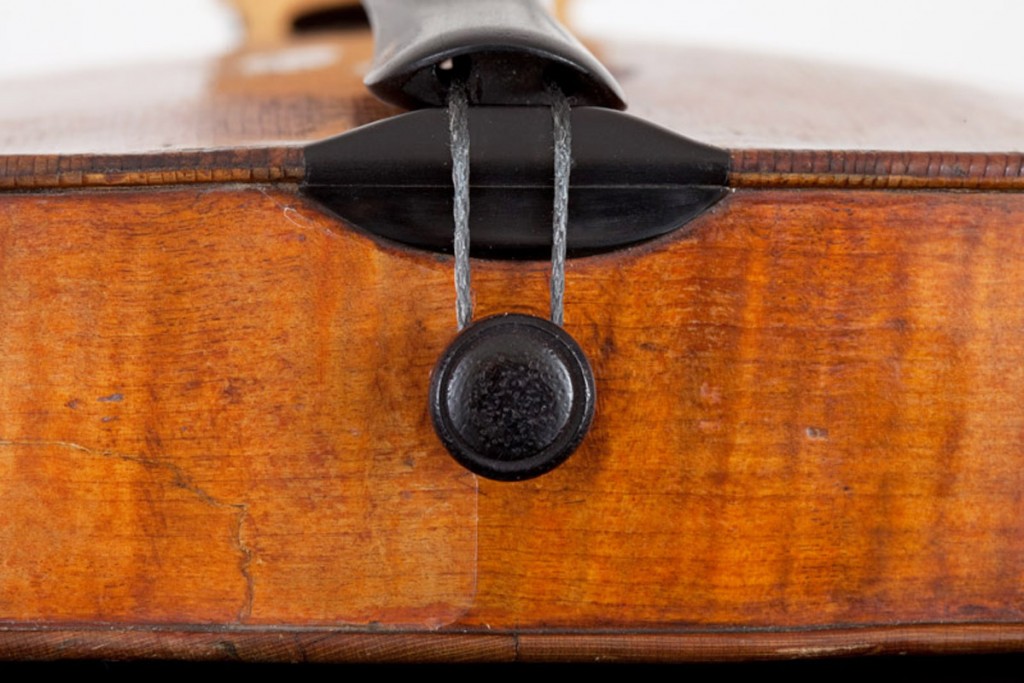
ところで ピアノは弦( ミュージックワイヤー )がエンドピンの位置までそのまま張られていますが 、ヴァイオリンなどの弦楽器はひも状の テールガットやテールナイロン そして写真にあるカーボン繊維で作られたテールコードなどが弦の末端の役割を果たしています。
このため‥ この部分は弦楽器の響きにおおきな影響をあたえています。
因みに、テールコードは ボワ・ダルモニ( Bois d’Harmonie )などが販売する非常に軽くて丈夫な素材のアラミド繊維(
個人的な結論ですが テールコードは 響胴が硬い楽器には有効で 高音域は多少さえますが低音域を失う傾向があります。このため、私は 限定的な使用にとどめています。
私は 弦楽器の多くは弦が響胴に ねじりを加え 弛める仕掛けが 美しい音色を作り出していると考えているからです。
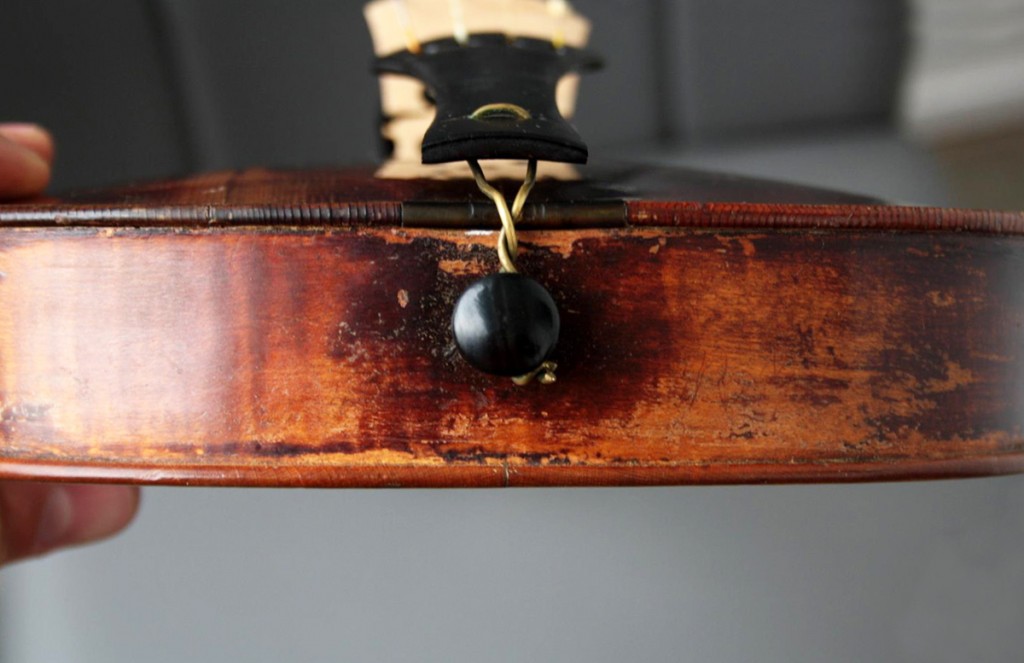
ところで、少し前ですが フェイスブックで 独創的な工夫をしたこの写真が流れてきました。真鍮でしょうか‥ 少なくとも このねじりは有効だと私も考えます。バロック・バイオリンですからテールピースもねじれ易く、音響的にはそれほど破綻していないと想像します。
私もスチールやチタン、額縁ワイヤーを使用した弦楽器は知っていますが真鍮はまだ実験していません。
下図にあるようにサウンドホールが二つある弦楽器では 金属線やワイヤー、テールコードなどを使用すると点 C、点 D がすばやく近寄ってしまうことで 点 B、点 A の倒れ込みが阻害されてしまい共鳴が失われ易くなることを 私は知っているからです。
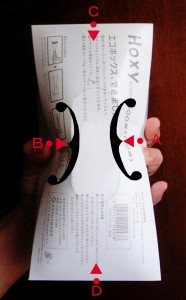
そもそもヴァイオリンなどの弦楽器では 黎明期から戦後すぐまでの 430年ほどの間、下写真の 1741年製 ガルネリ・デル・ジェス “Vieuxtemps” のように 当然ですが テールガットが用いられていました。
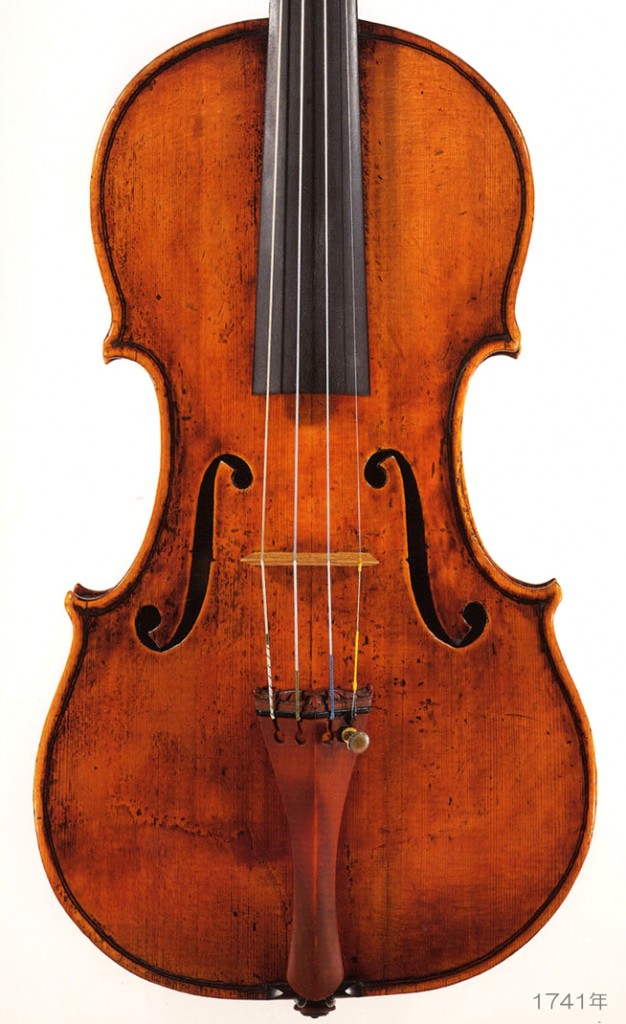
December 3rd, 2013 article The Economist reported that the purchase price of the “Vieuxtemps” violin exceeded $16 million.
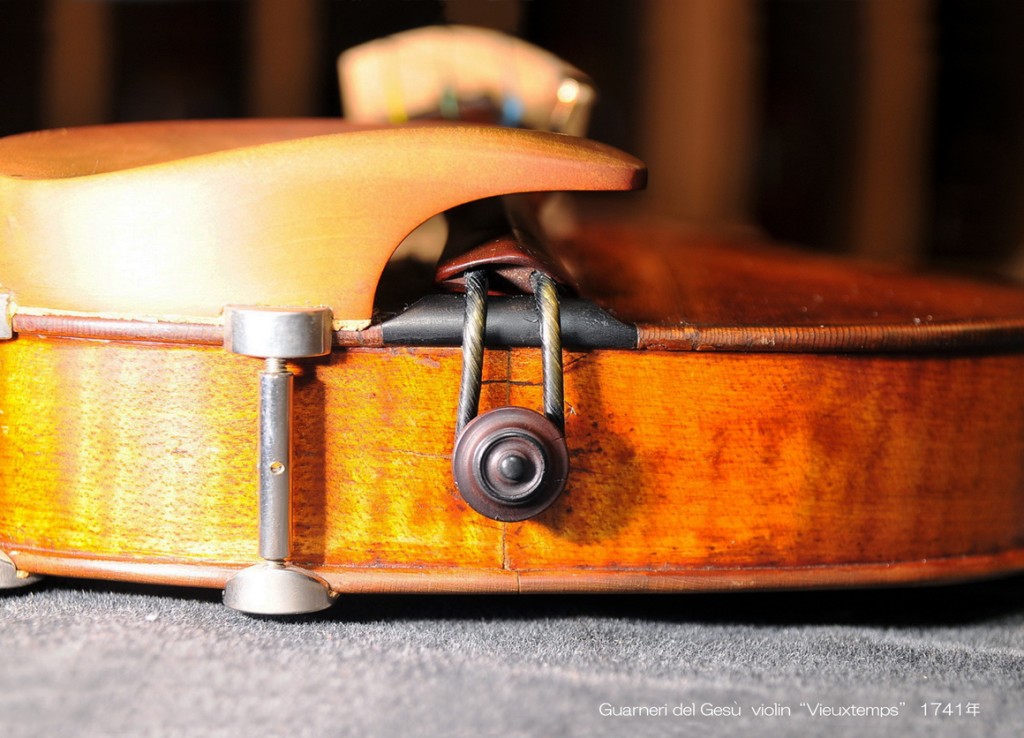
日本円で16億円以上 ‥ 。そして、それを終身貸与されている アン・アキコ・マイヤースさんもテールガットのままで使用されているようです。
現代では新素材などの影響もあり あたかも選択肢は多数あるようにみえますが、私はテールガットは最良の選択だと考えています。
不幸なことに テールガットを ガット弦の不安定性( 上質なしなやかさ )と同じイメージでとらえてしまう方が増えてしまいましたが 実際にテールガットはガット弦と違い 丈夫なのです。
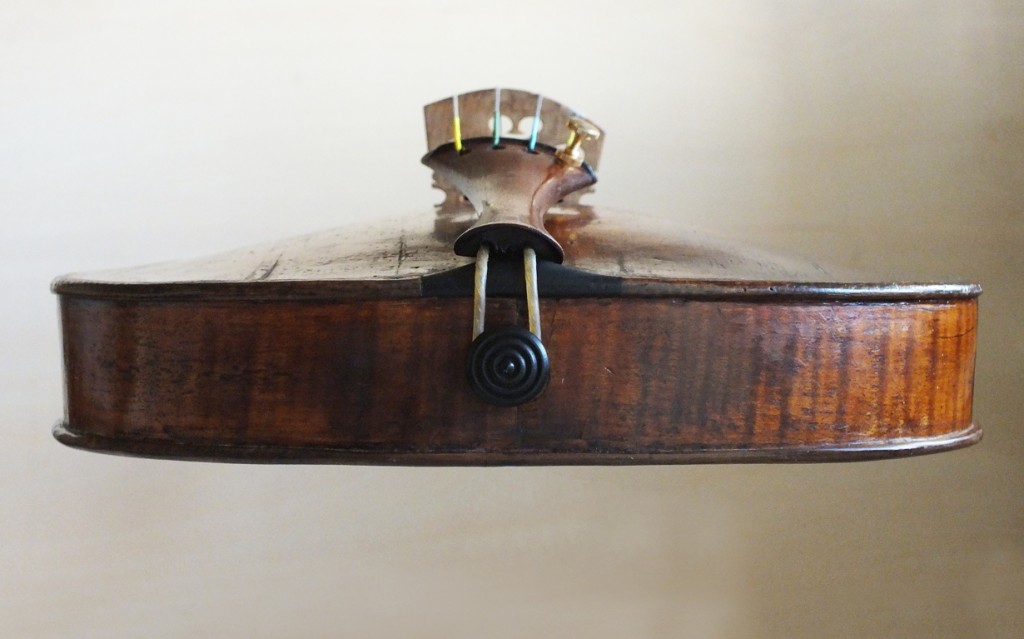 私は TORO社のテールガットを本結び( リーフノットまたはヘラクレスの結び )で 長さの調整をして使用しています。弦楽器に取り付ける場合の技術的な熟練には数年を要しましたが、私はこの製品を使用していて今までほとんど不都合を感じたことがありません。
私は TORO社のテールガットを本結び( リーフノットまたはヘラクレスの結び )で 長さの調整をして使用しています。弦楽器に取り付ける場合の技術的な熟練には数年を要しましたが、私はこの製品を使用していて今までほとんど不都合を感じたことがありません。
たとえば強度上の特性はコントラバスにテールガットを取り付けることで確認できましたし、テールガットの長さについては テールピースと駒の距離を適切に選ぶことでテールピースの良好な振動をえらぶことが可能なことを知りました。
私は テールガットは ねじって製造されていることで弦楽器の響胴のねじりをサポートし、それが豊かな共鳴音につながっていると考えています。これは前出の写真のように金属線をねじるより遙かに合理的です。
さて、私は この投稿を 弦楽器工房を営む同業者の方に「 40年程前からテールナイロンの普及によりテールガットを使用している人は少数派となってしまいましたが、 TORO社のテールガットは代理店である ムジカアンティカ湘南( 社名:コースタールトレーディング )で購入出来ますので、是非ためしてみてください。」とお伝えしたくて書いています。
私は 心からテールガットが再び主役の座に帰り着くことを望んでいるのです。
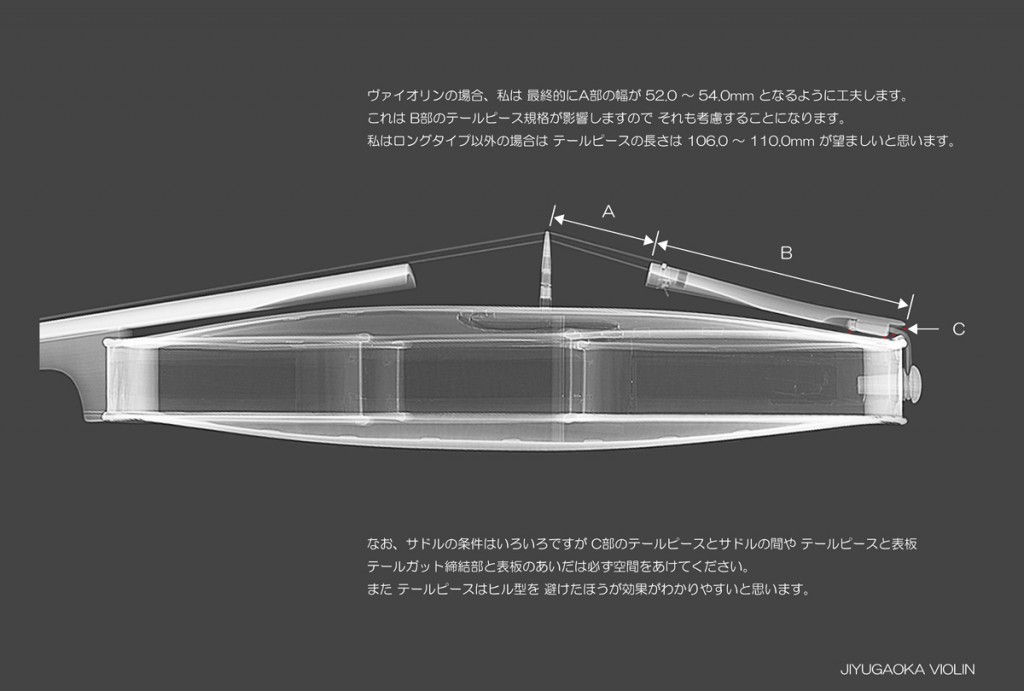
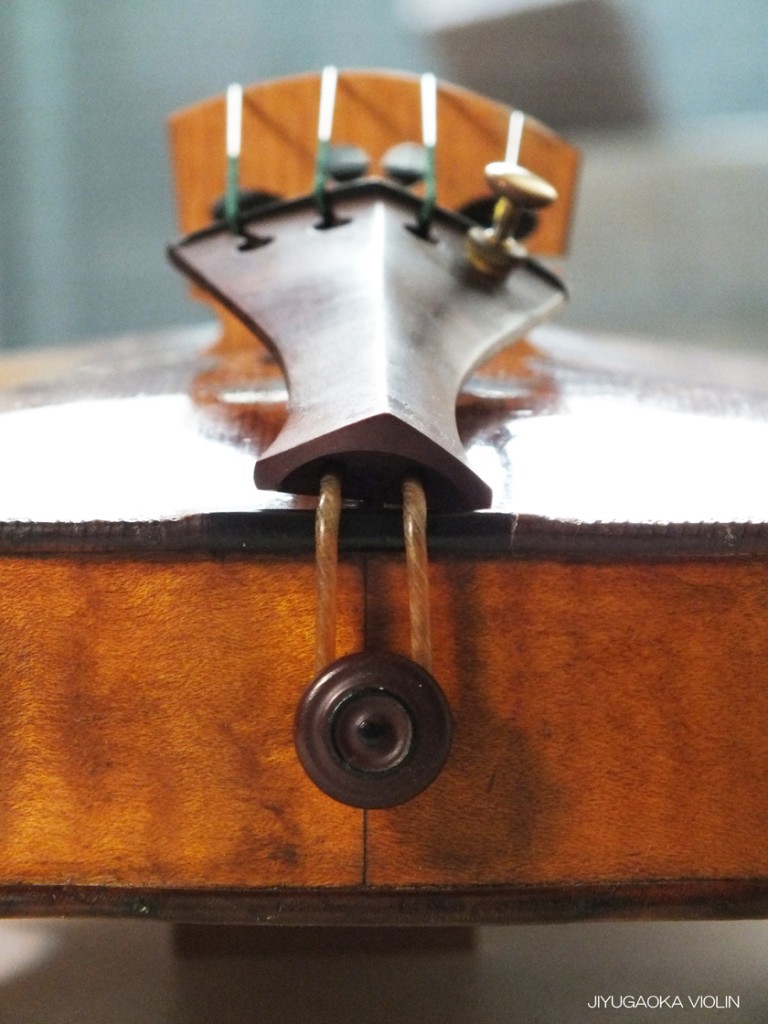
ヒル型テールピース
そこで‥ 初めての方には多少は役に立つかもしれないので、ここからテールガット取りつけの実例をあげさせていただきます。
1. ガットのゲージについて
ガットのゲージ( 直径 )ですが 私はヴァイオリンの場合で TORO tail gut No.200 または No.220 を選択しています。このほかに楽器条件によっては Contrabass G string No.230 を使用する場合があります。
ガットは製造時期などの諸条件でメーカー出荷時から多少規格が変化することがありますので、私は 入荷したガットは30年程前に購入したピラストロ社の直径計測器で確認しています。
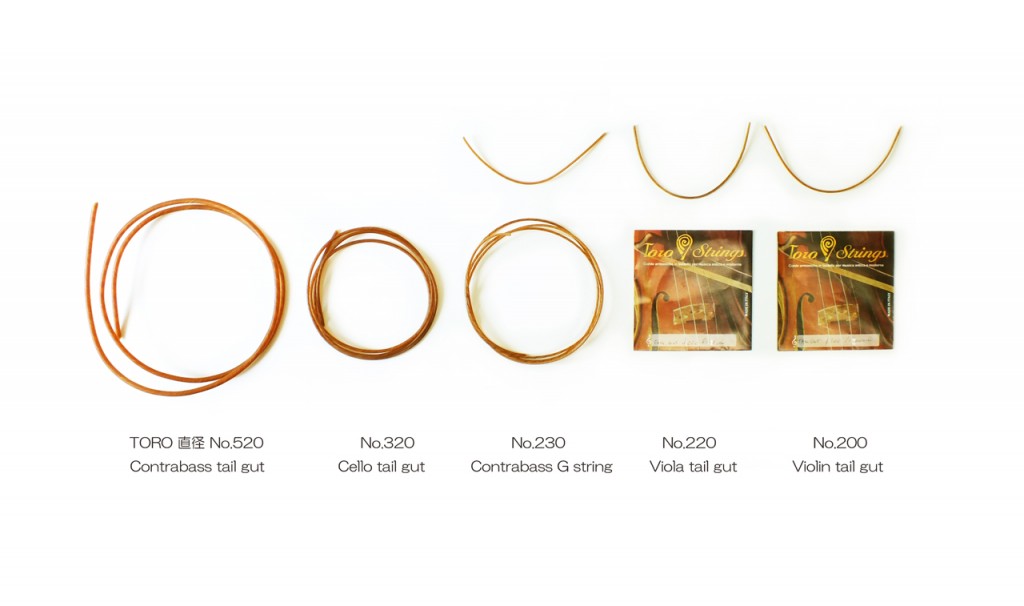
これはピラストロ社のガット弦直径検査用なので 計測時の圧力がソフトです。 私はとても気に入っています。
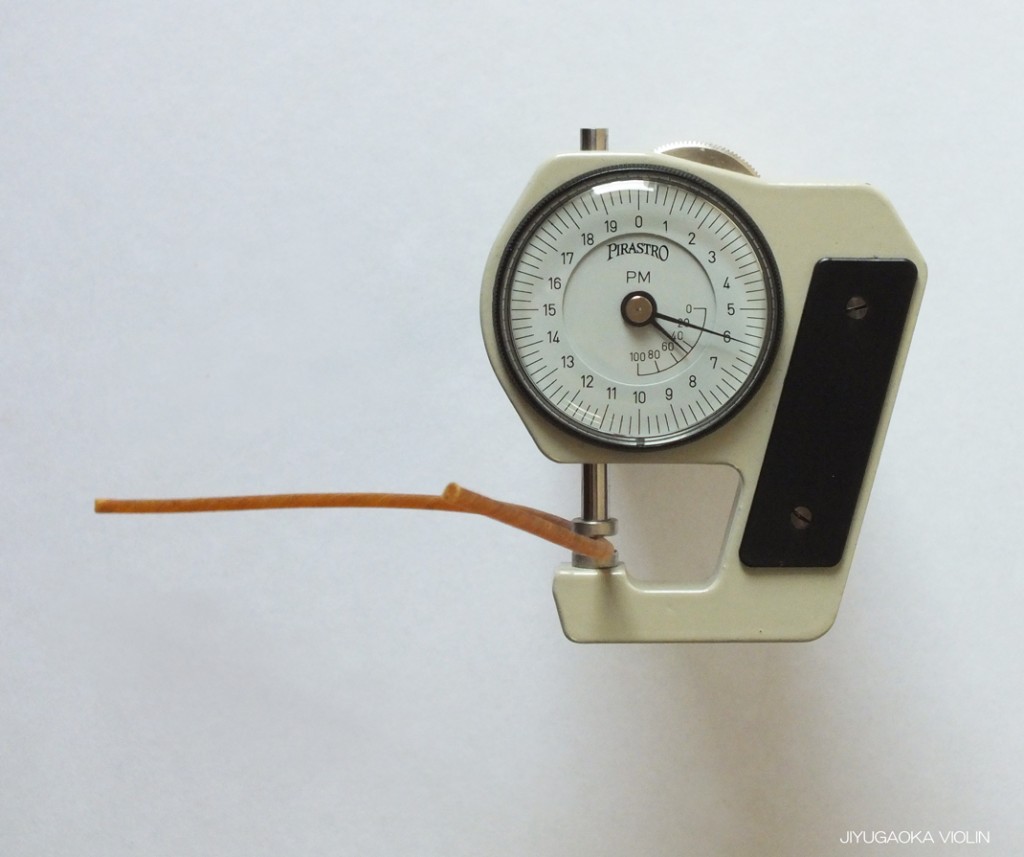 TORO 直径 No.230( Contrabass G string )
TORO 直径 No.230( Contrabass G string )
PIRASTRO String gauge 46.0
因みにピラストロ社の直径計測器は 目盛りが TORO社の 1/5になっていますが換算は簡単ですね。
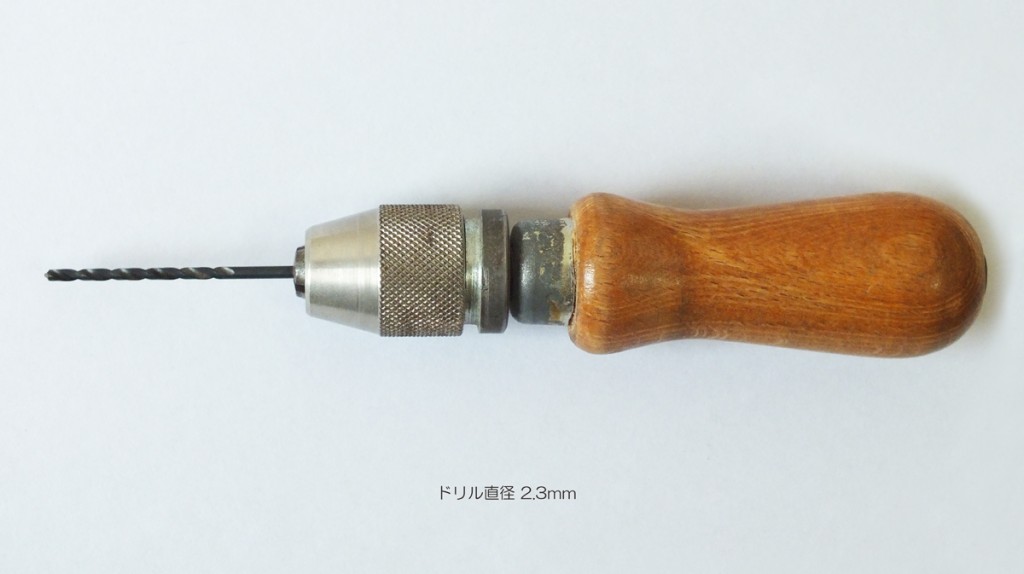
なお、この太さのテールガット( No.230 )をヴァイオリンやビオラに使用する場合は、テールピース穴を直径2.3mmのドリルで大きくする必要があります。
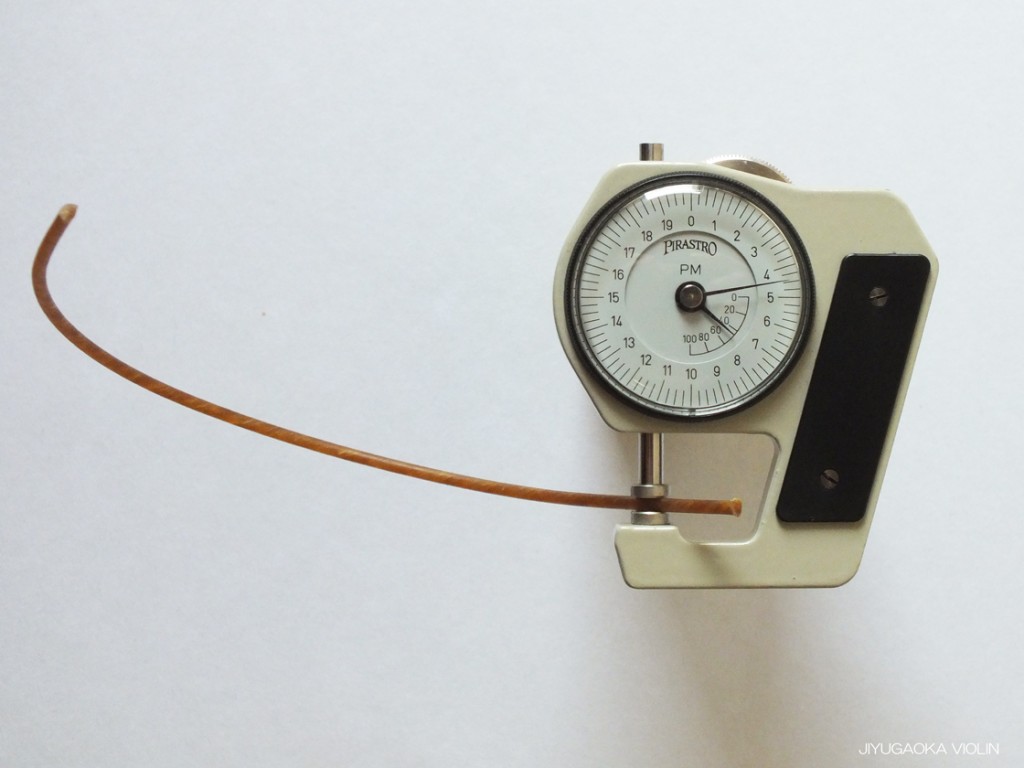 TORO 直径 No.220( Viola tail gut )
TORO 直径 No.220( Viola tail gut )
PIRASTRO String gauge 44 1/2
私も以前は 市販のマイクロメーターを使用していました。
ラチェットストップ付きなので 検査傷はそれほど心配いらないのですが、ガット製品は結構‥ 直径が不揃いですから マイクロメーターのレベルで計測していると心の病に陥りそうなのでやめました。
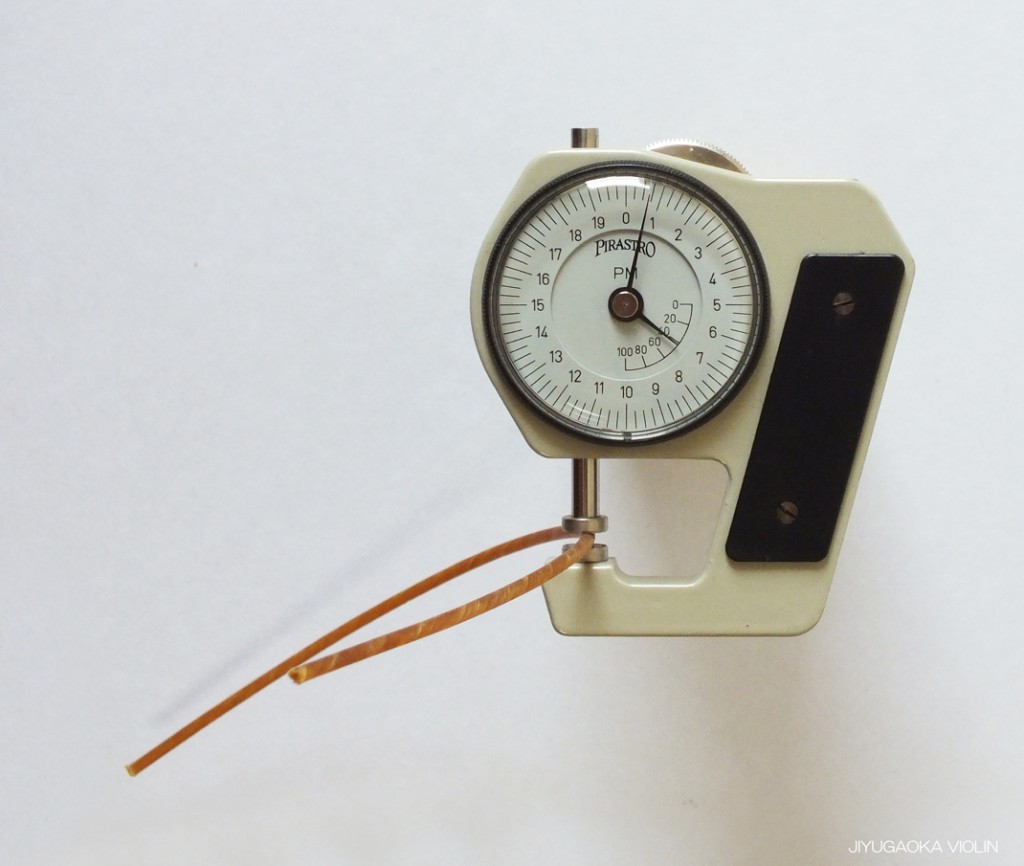 TORO 直径 No.200( Violin tail gut )
TORO 直径 No.200( Violin tail gut )
PIRASTRO String gauge 40 3/4
私は 一般的なガット製品は 時間の経過により痩せることを考慮して、この TORO社のヴァイオリン用テールガットのように出荷時は表示より少し太めとされていると推測しています。
このように同じ製品単位( ロット )でも 私は実測して使い分けていますが、その結果はなかなか興味深いものでした。
ゲージに関しては 経験則が必要ですので、まずは計測し記録することから始めてください。
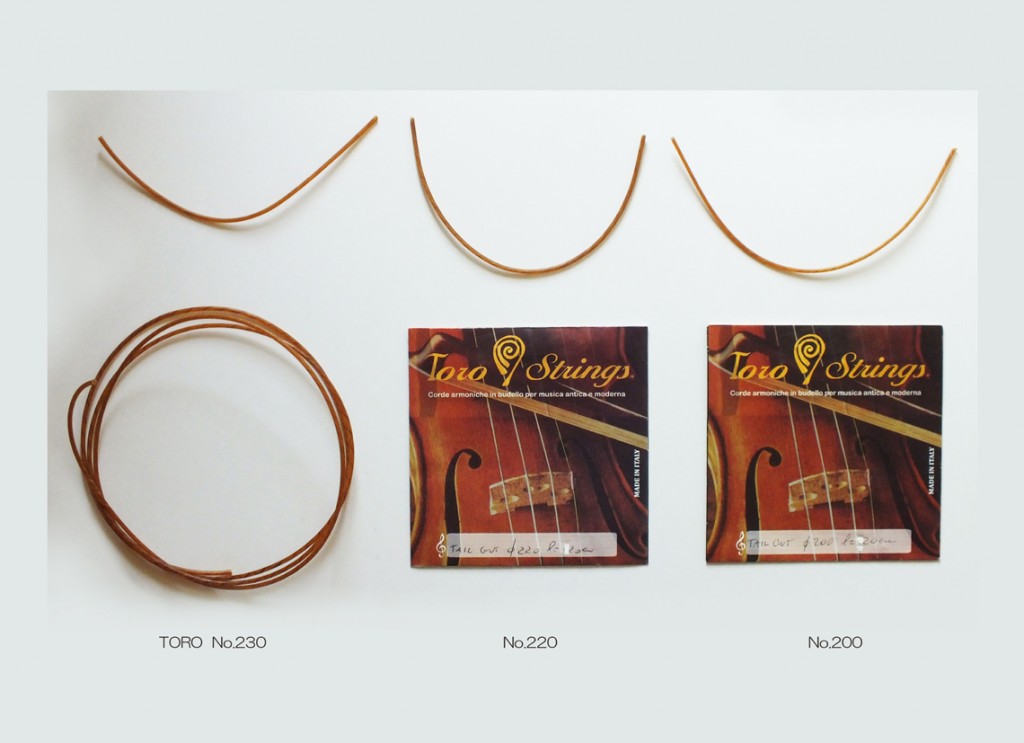
2. 作業のはじめに ガットの長さを決定します
今回は実例として 2004年製の YAMAHA violin に、 TORO社 No.200( Violin tail gut / PIRASTRO String gauge 40 3/4 )を取り付けました。
私はこれらのガット製品は入荷時の直径確認後 すぐにトリートメントして保管しています。このため 今回のように使用時は本結びなどの加工がしやすくなっています。
このヴァイオリンのテールピース長は 110.0mm で 依頼された時には駒とテールピースの距離 ( A )が 44.0mm でしたが、私は 52.0mm に設定することにしました。
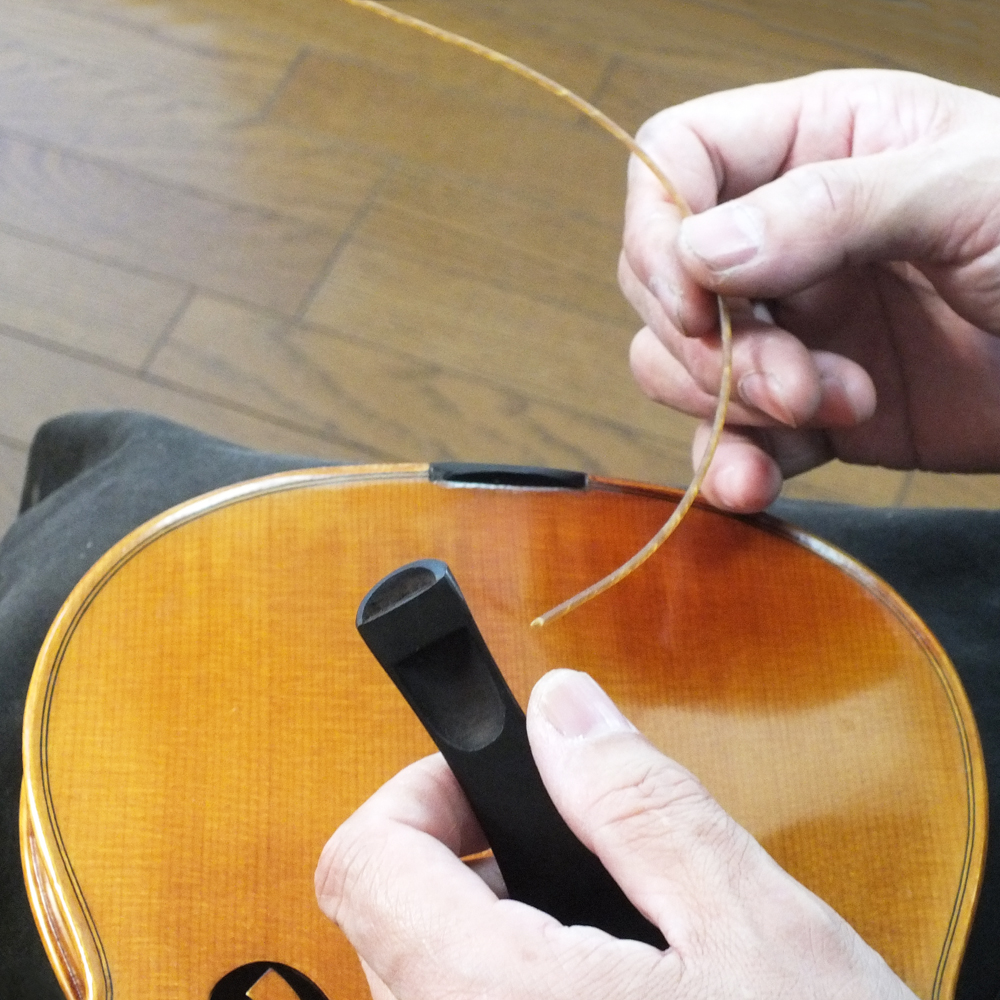
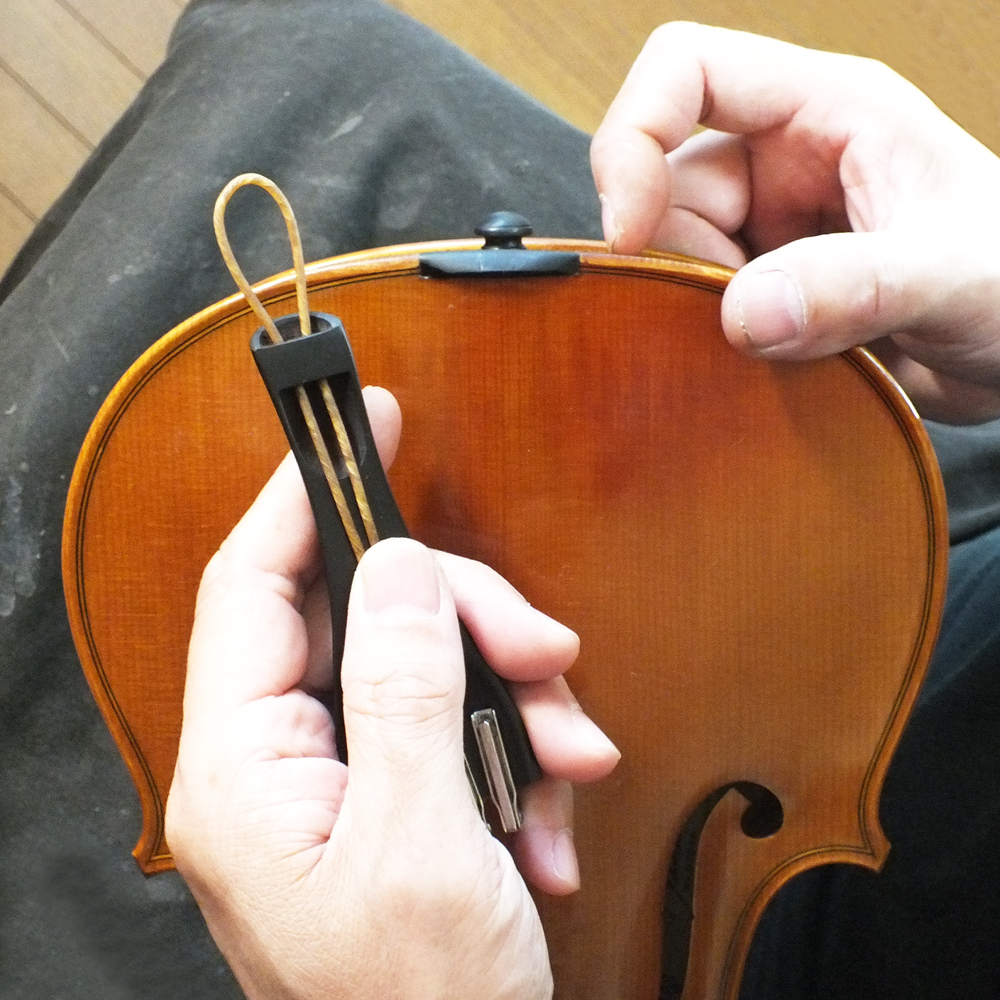
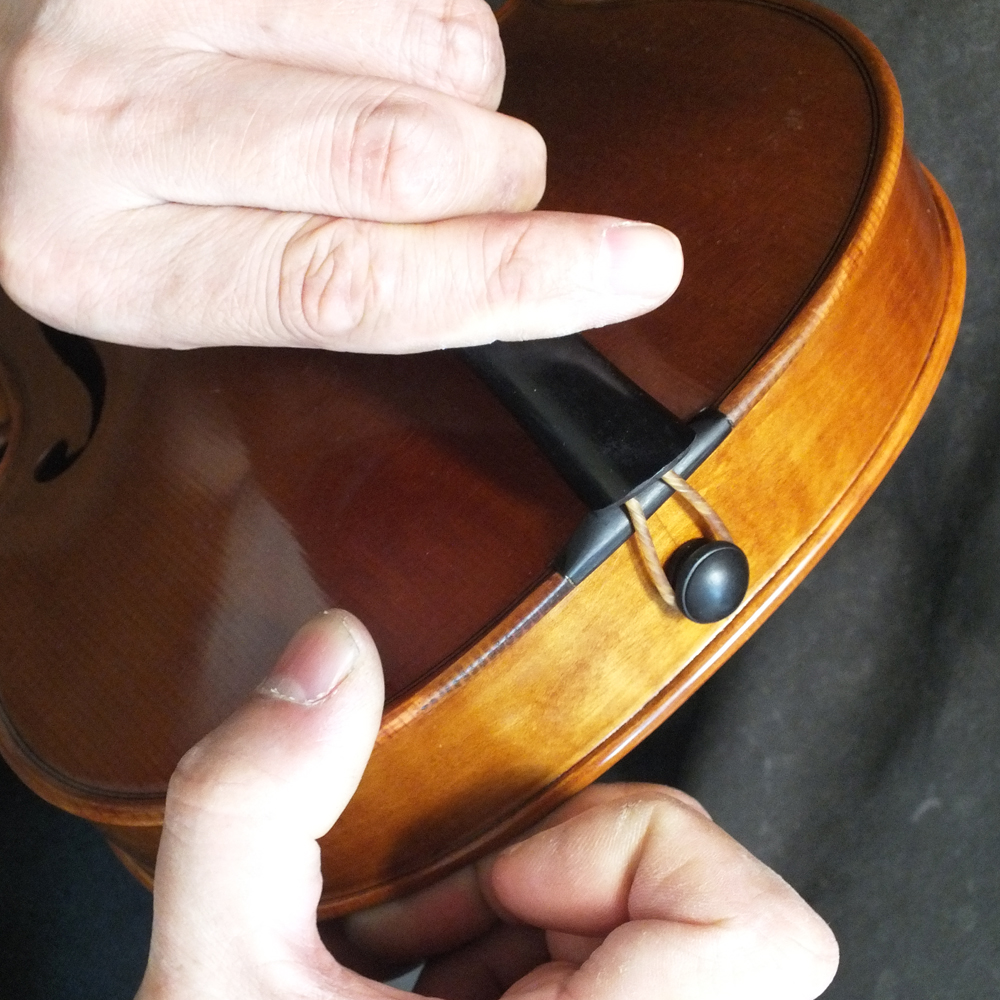
( A ) を 52.0mm に設定するためには、このヴァイオリンでは ガットをギリギリに短くする必要があります。
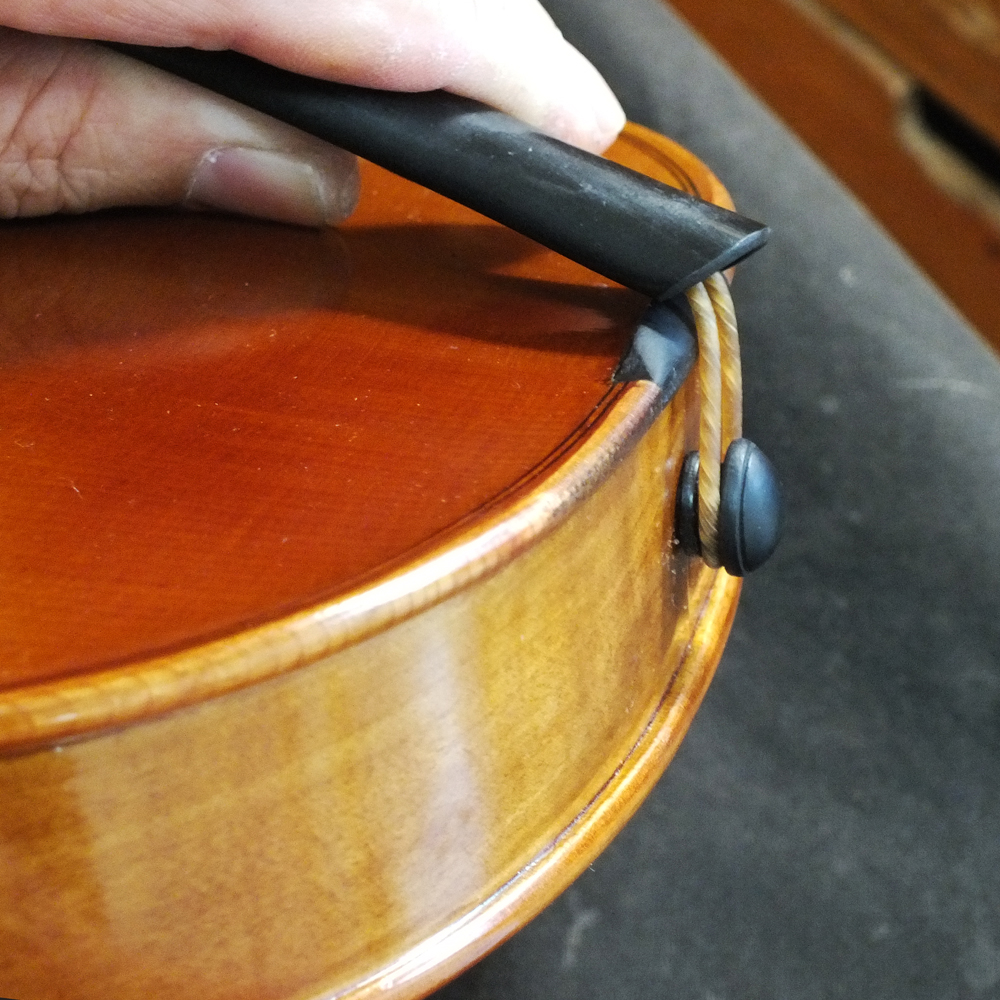
私は 結び目が締まって長くなることを考慮してこの長さを選びました。そして後の工程のために マジックでマークをいれました。
3. 本結びにはいります
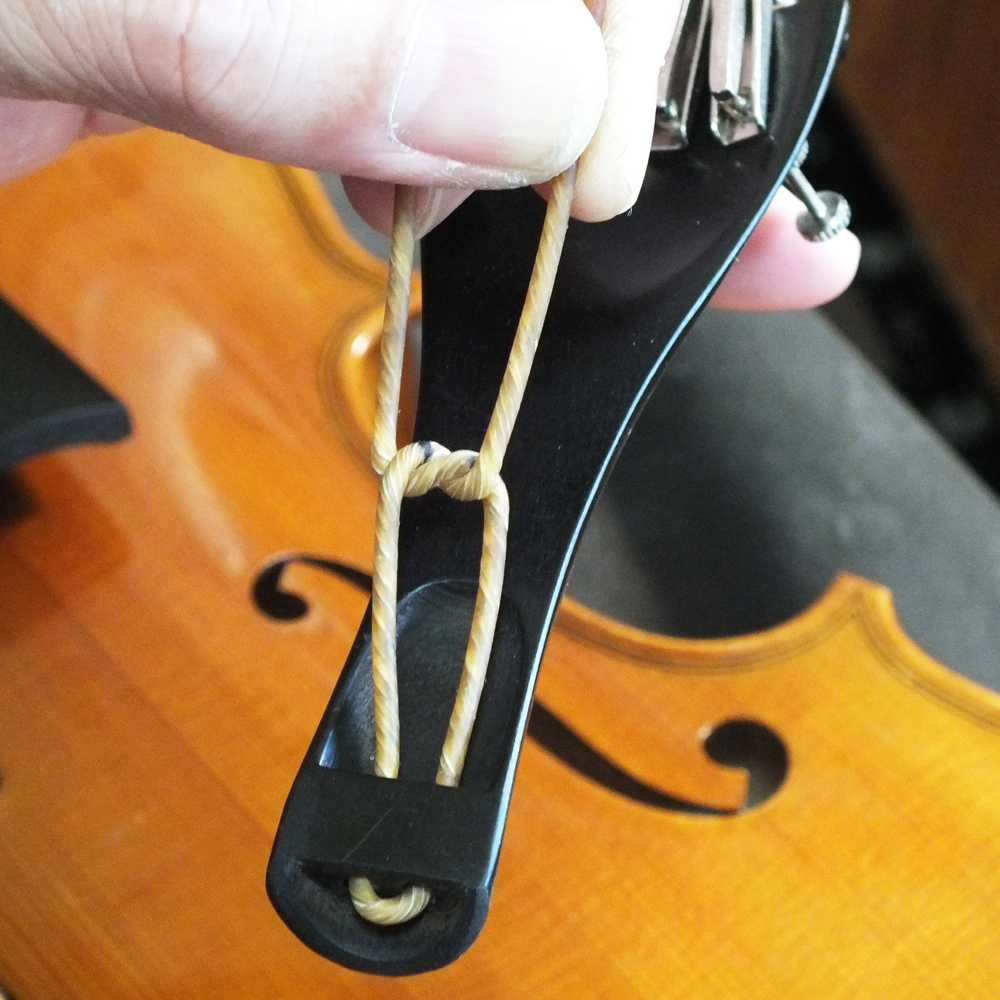
決定した長さになるようにガットに折り目をつけながら なるべく結び目が小さくなるように工夫します。
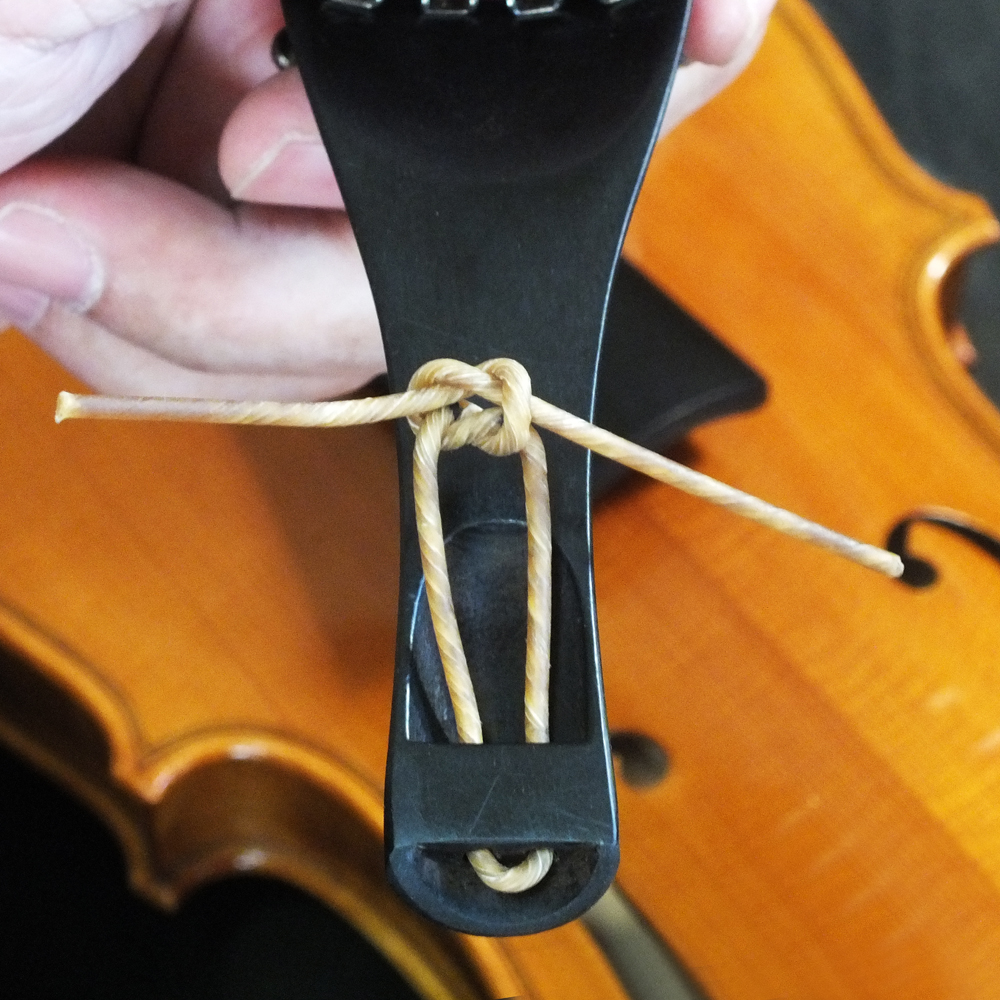
4. テールガット端の処理
テールピースの裏穴規格にもよりますが、私はガット端の熱処理部の長さは ヴァイオリンの場合で 7.0mm 位としています。
では‥ まず 1回目の焼き入れです。
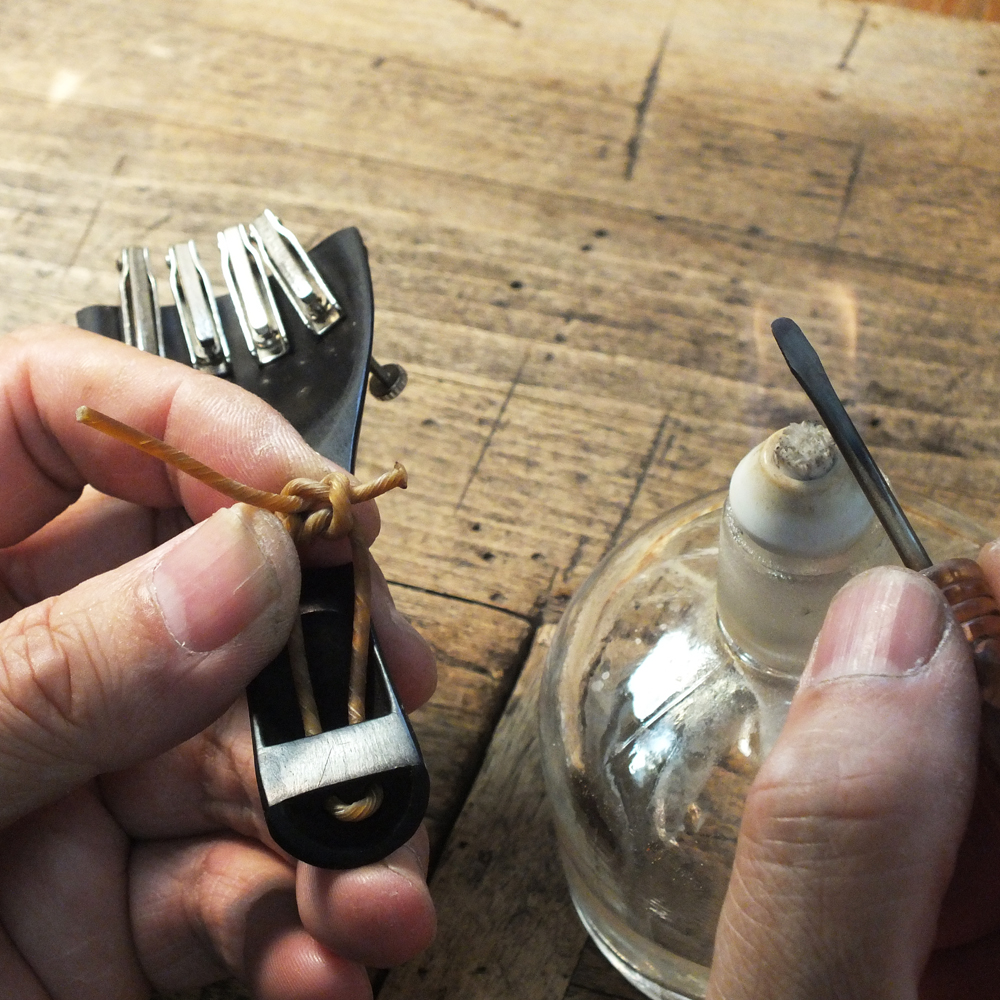
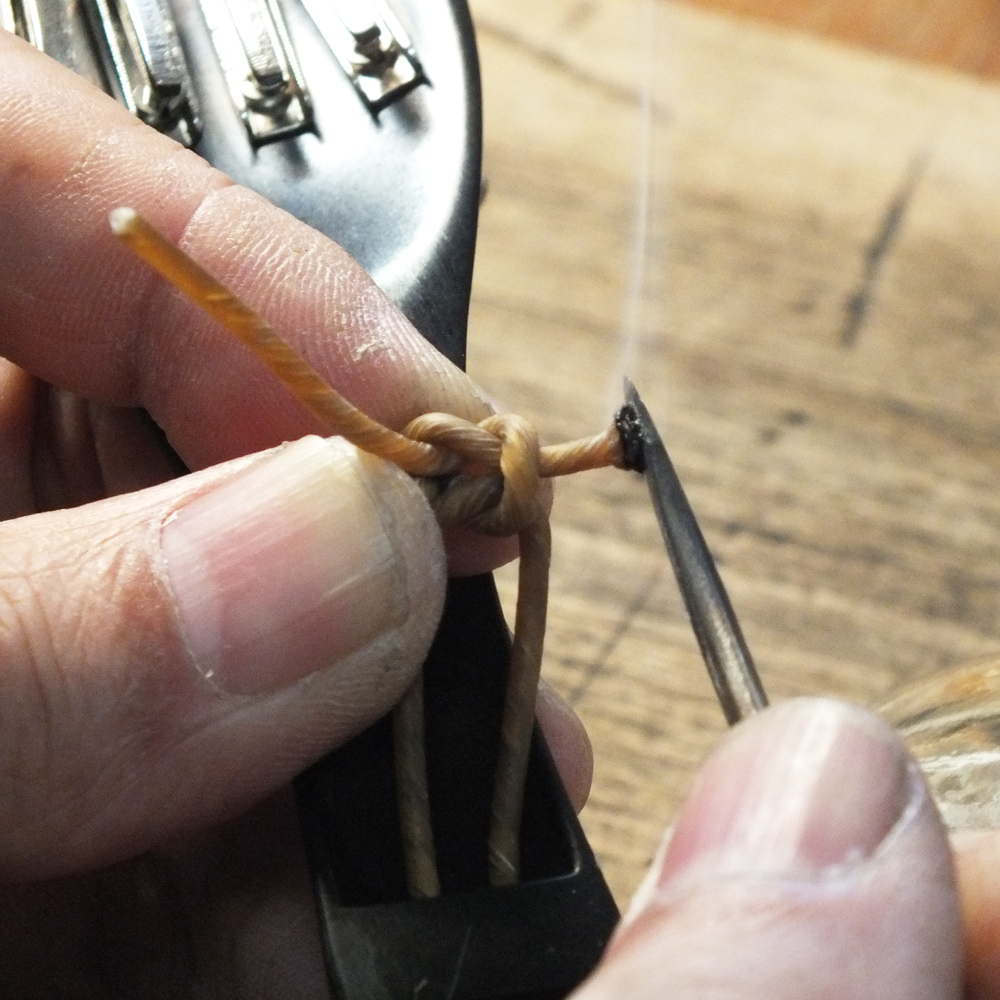
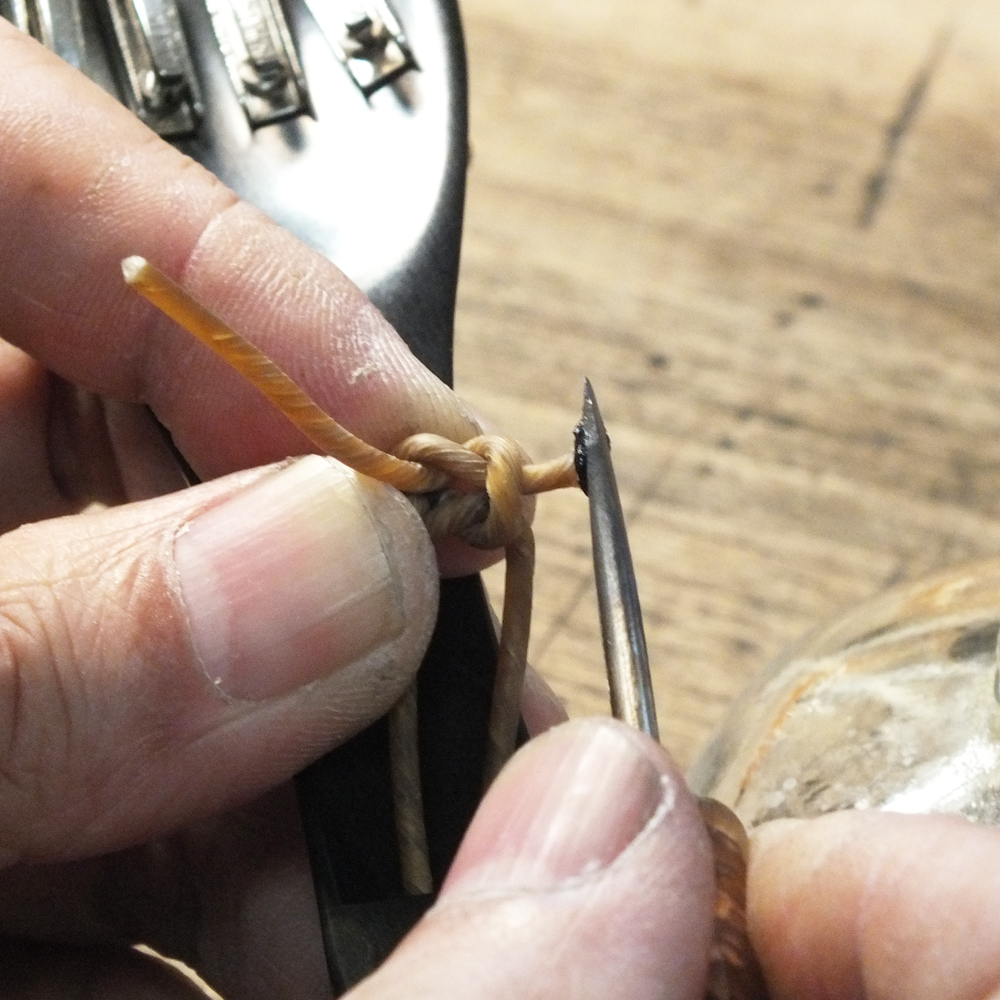
ガット端が熱でやわらかくなっているタイミングで 釘の頭状に成形します。
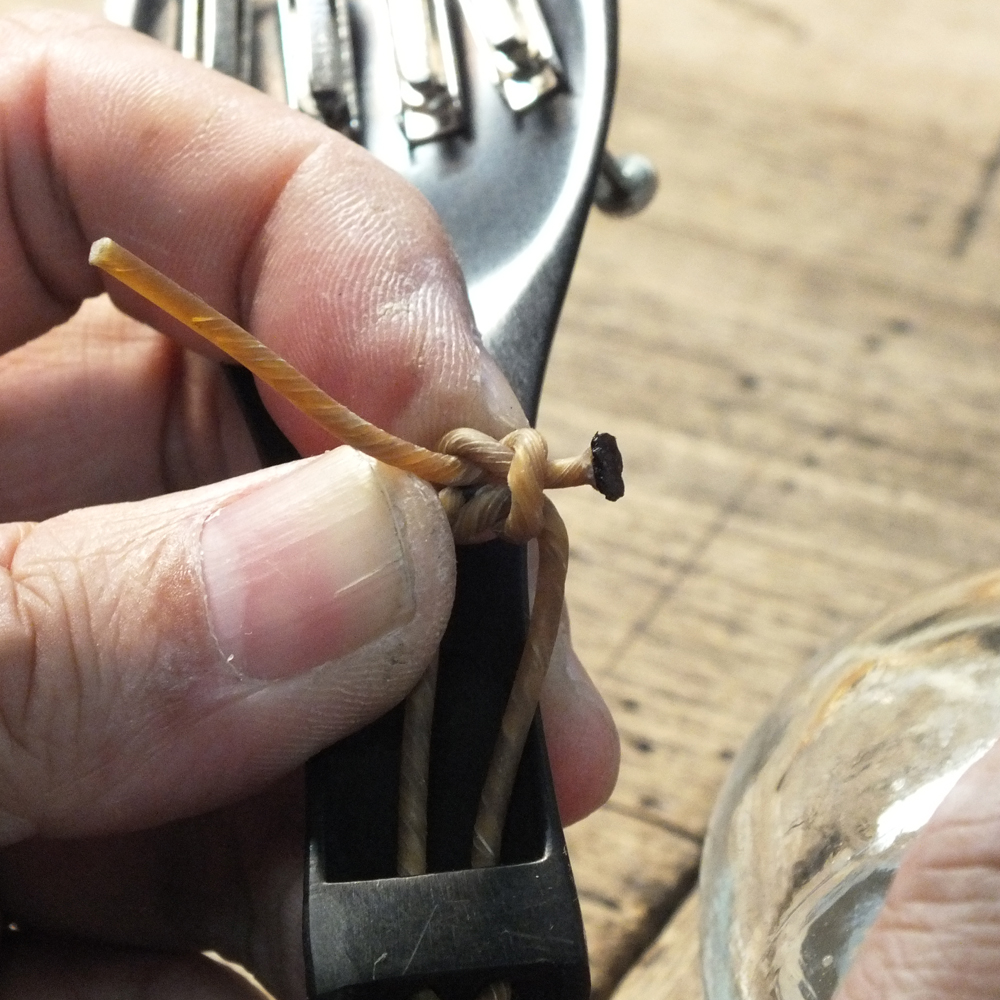
そして 2回目の焼き入れです。
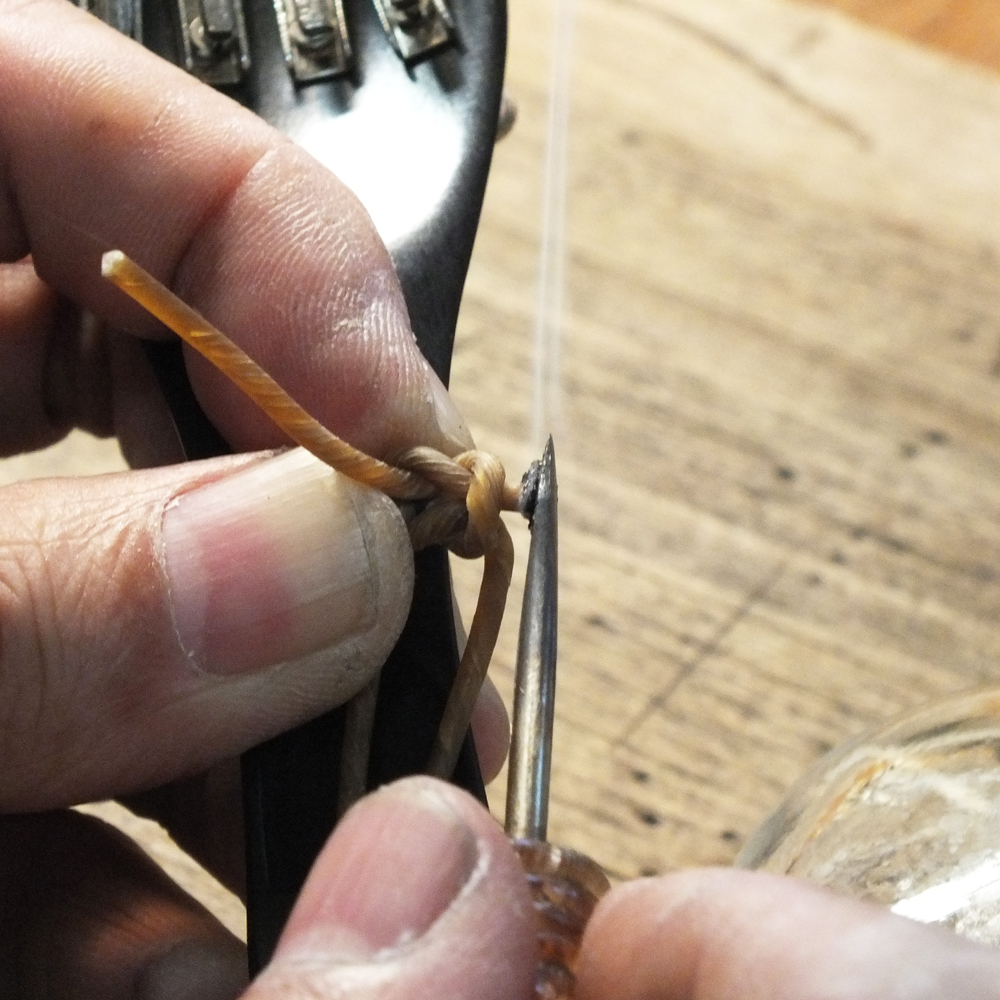
ガット端は根元付近まで加熱しますが本結び部を傷めないようにしてください。
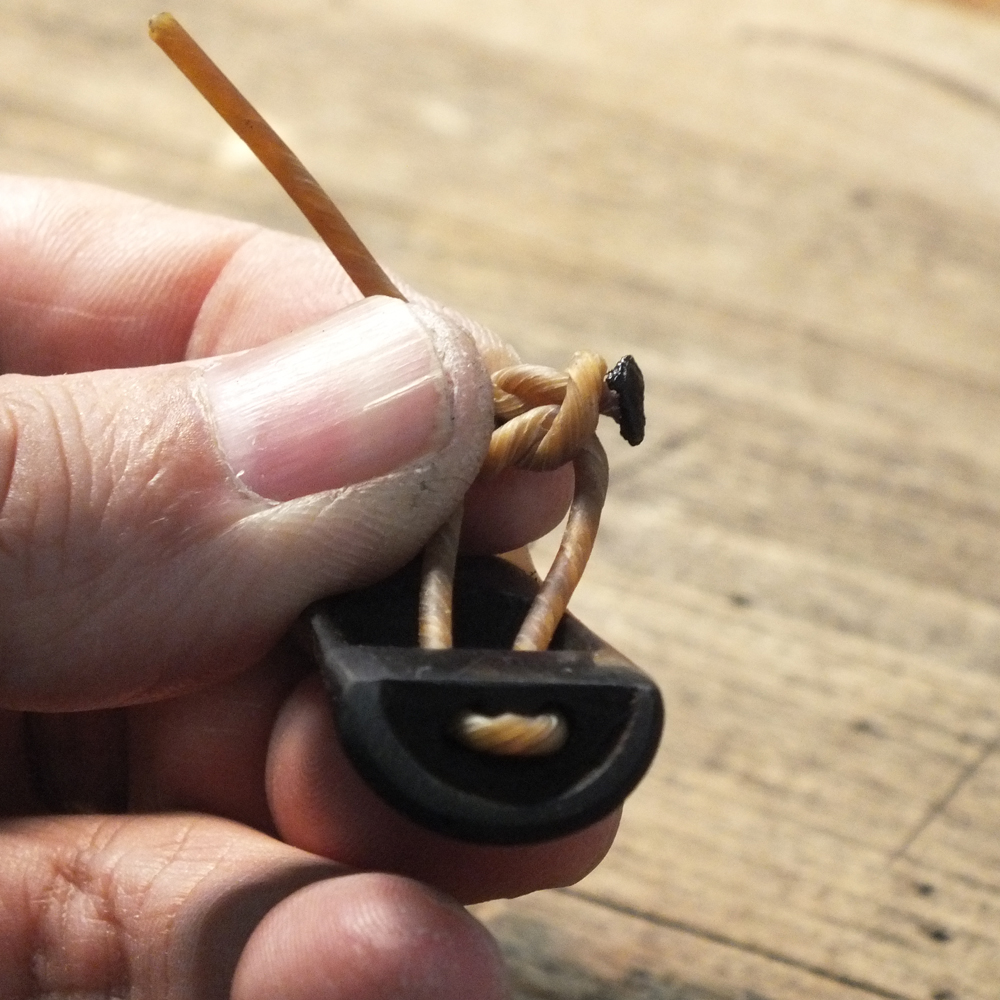
こんな感じでだいじょうぶです。
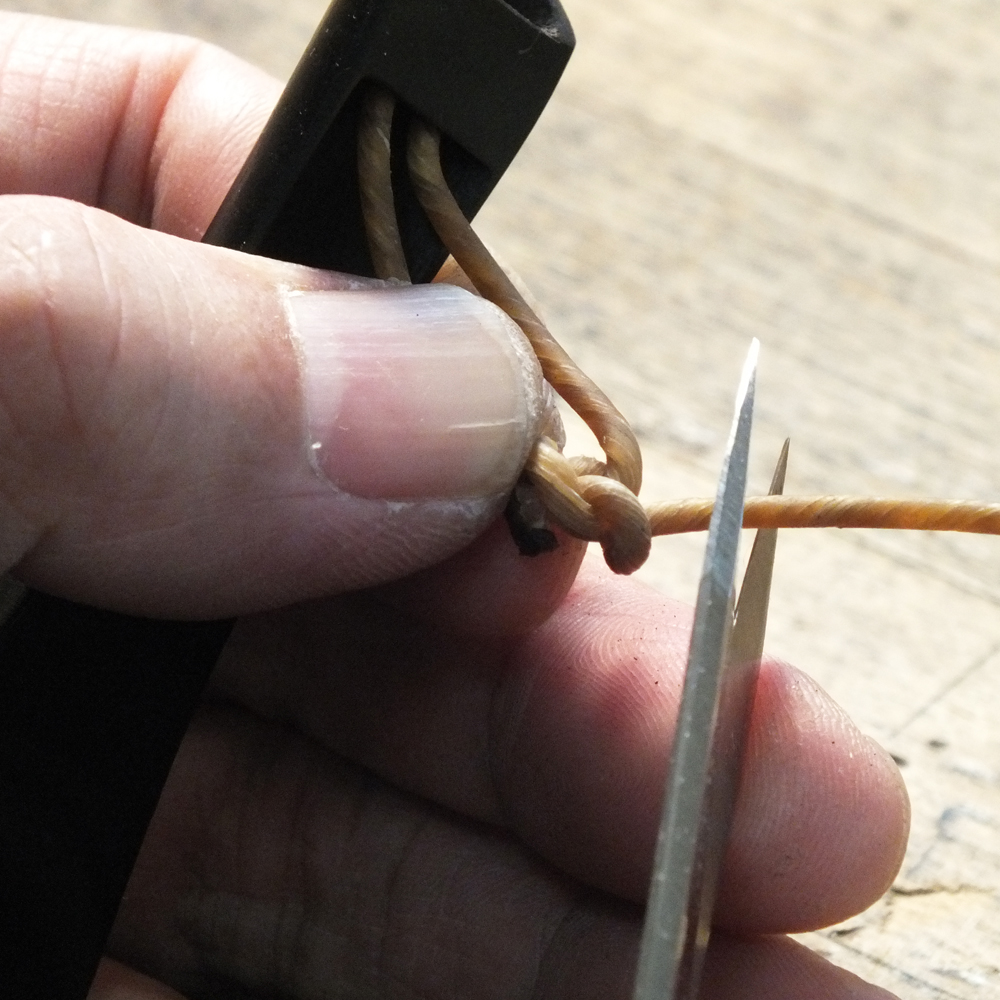 ここで反対側のガット端の工程に移ります。長さは おなじく 7.0mm位とします。
ここで反対側のガット端の工程に移ります。長さは おなじく 7.0mm位とします。
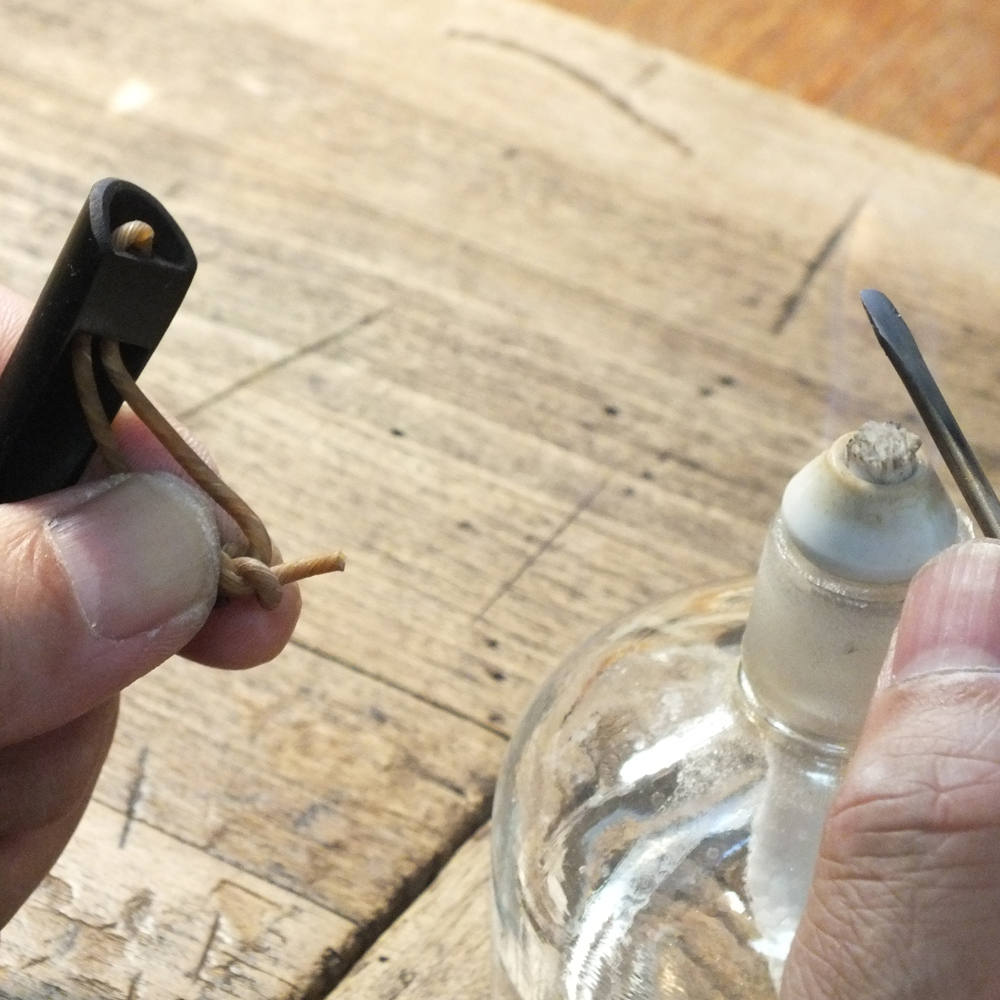
こちら側のガット端も 1回目の焼き入れをします。
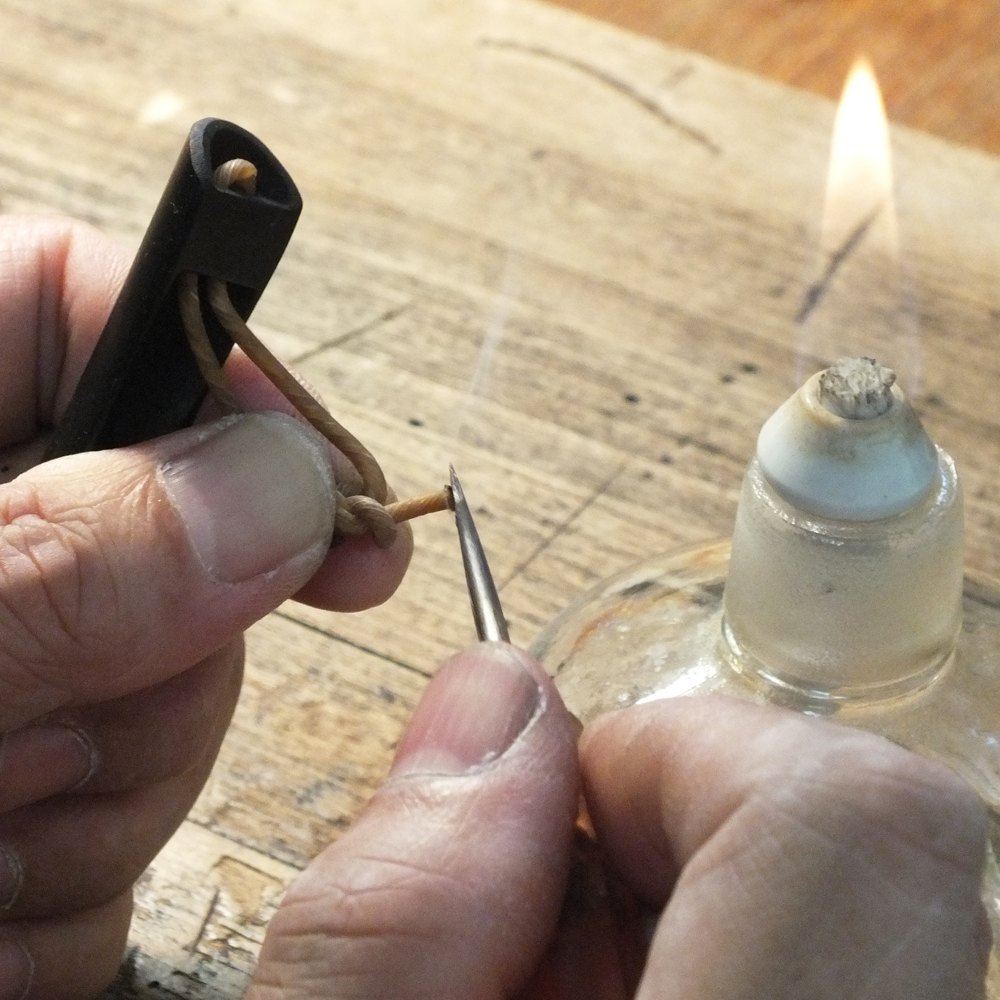
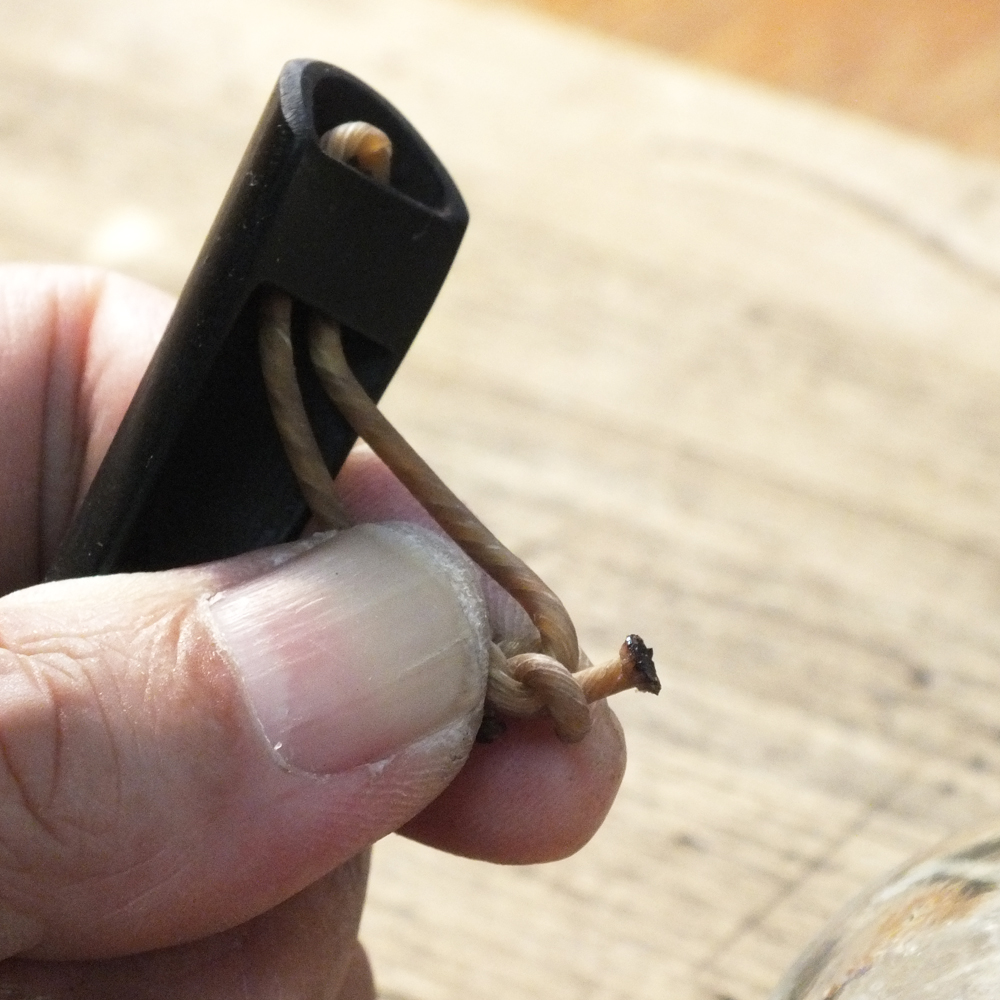
そして、2回目の焼き入れです。
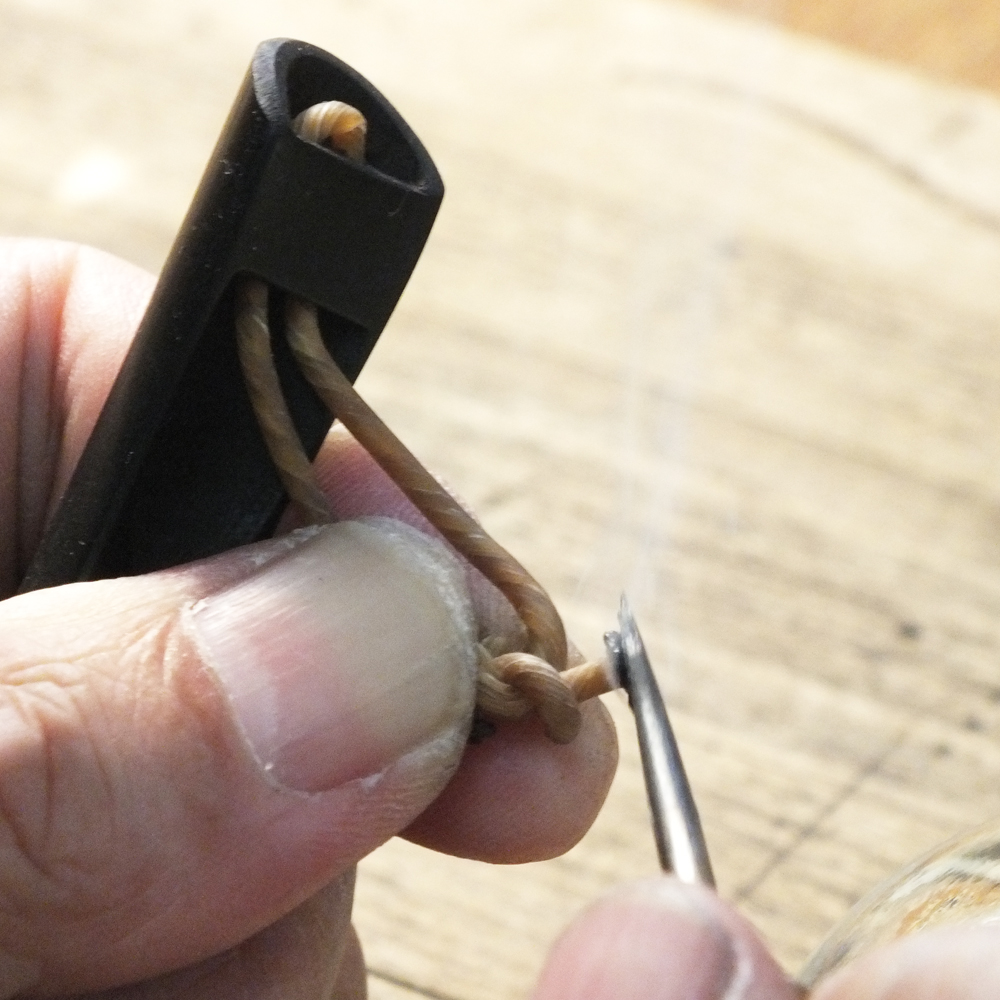
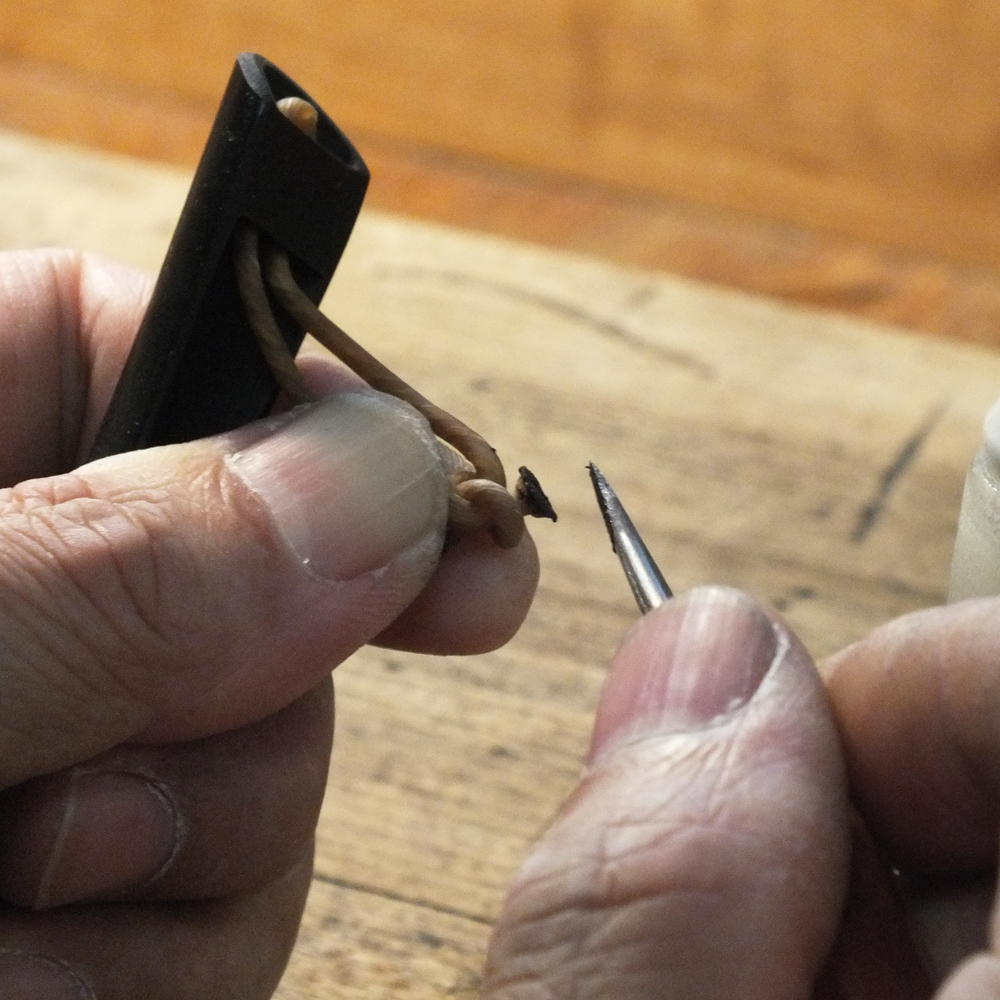 こちらも、こんな感じに加工します。
こちらも、こんな感じに加工します。
5. テールガットを トリートメントします
テールガットの取り付け作業はここから本番のようなものです。
ガット弦やテールガットの愛用者の中には ガットをオイル処理などをした上で使用されている方がいらっしゃいます。
私も そうです。ただし私の場合は オイルではなく 2種類の塗布材を使いトリートメントしています。
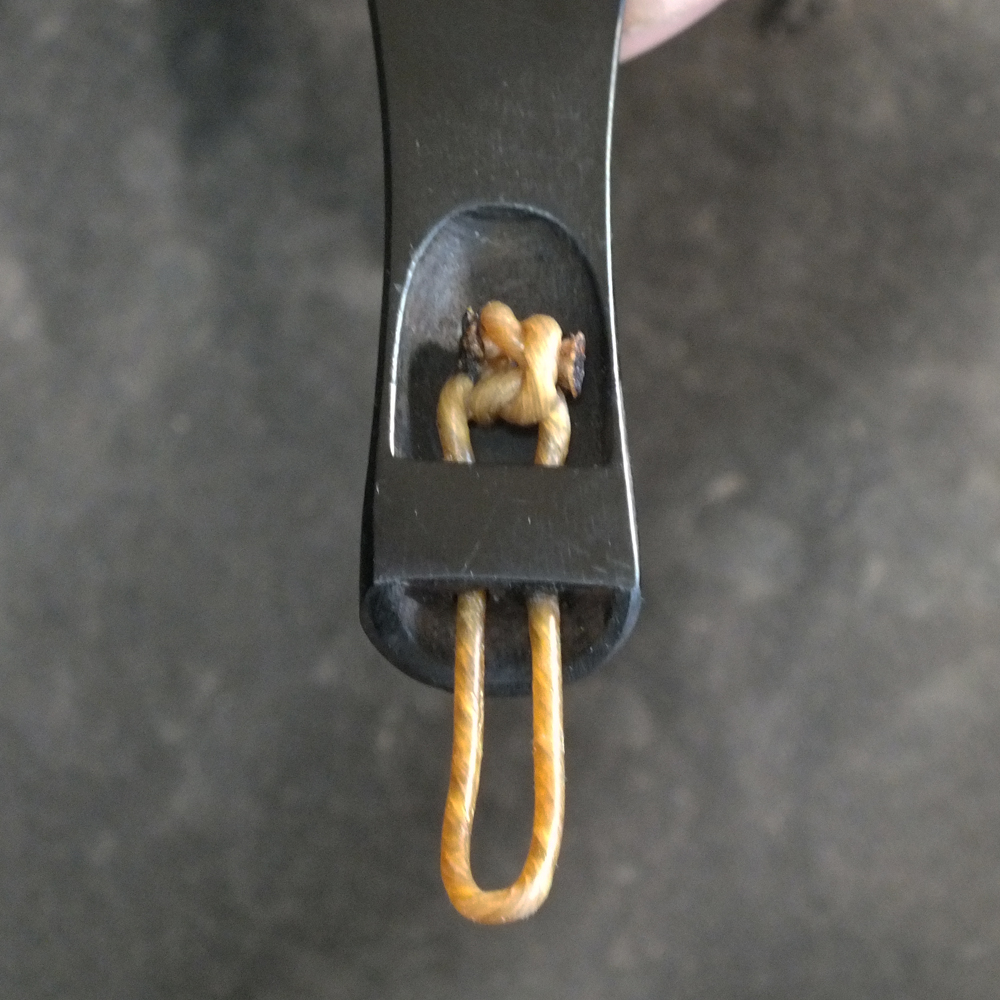
この後の締め込み工程のために ここでもう一度トリートメントをしました。
6. 本結びを締め込みます
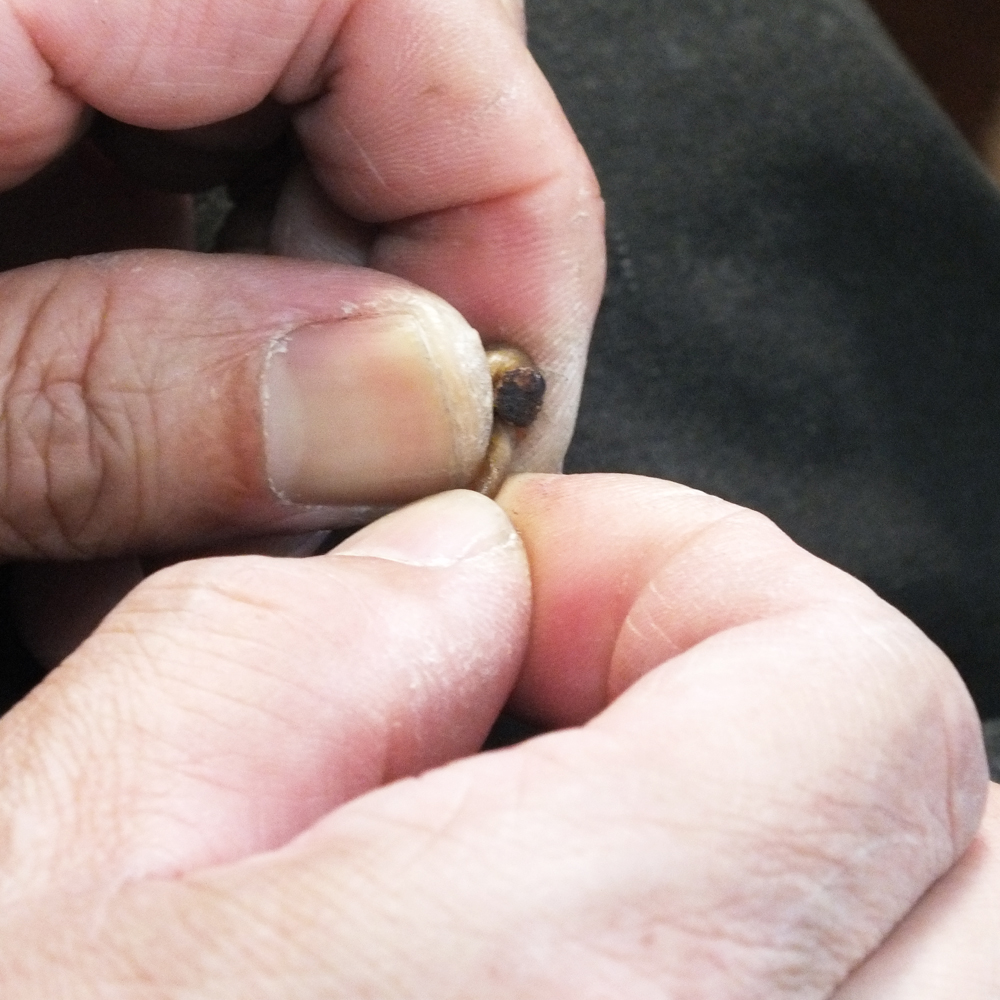
指のなかでもみ込んだり つまんで引っ張ったり、押し込んだりして、結び目が少しでも小さくなるように工夫します。
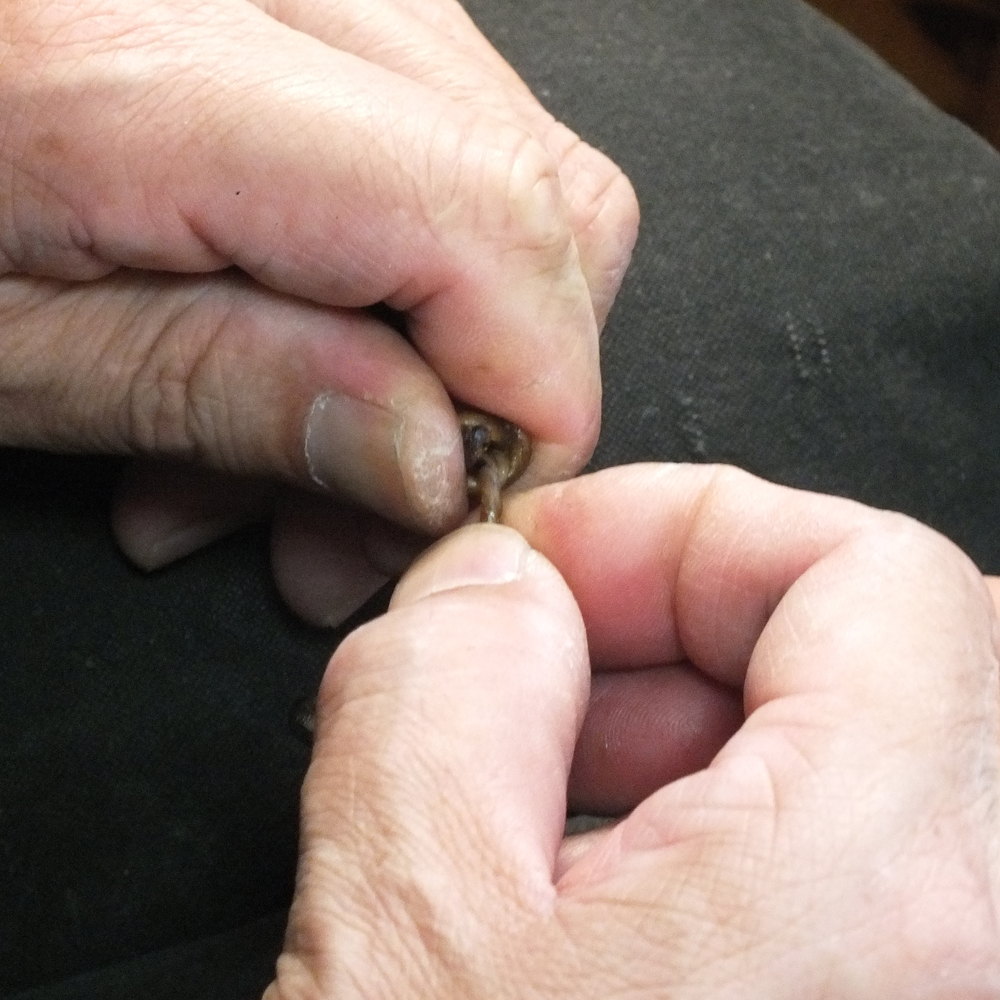
この工程は 結構 ‥ 指の力を使います。
7. 仮組工程
ヴァイオリンのテールピースに開けられているテールガット穴部は それほど丈夫ではありません。ガットを絞め込む際には 決して”テコ原理” を使わないでください。
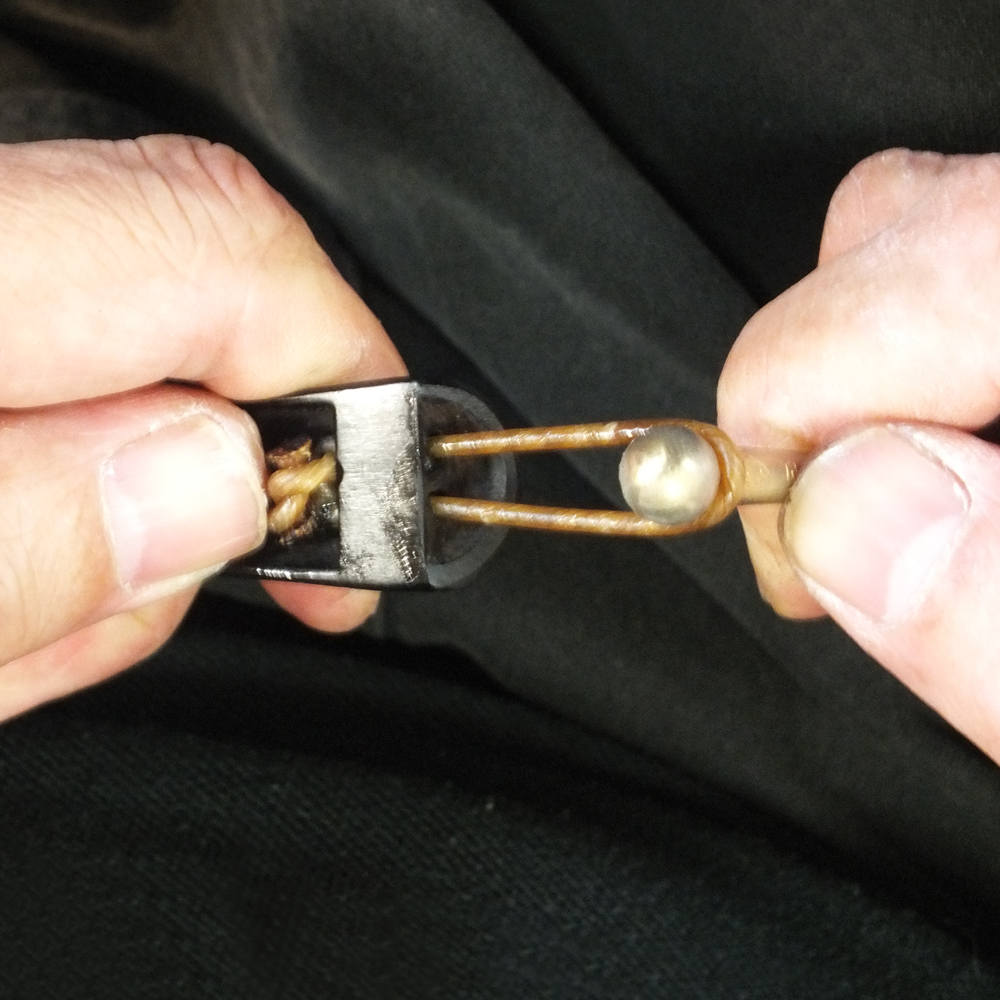
テールピースの材料特性とテールガット穴が開けられた位置によっては、この工程でテールピース穴部が割れてしまうことがあります。
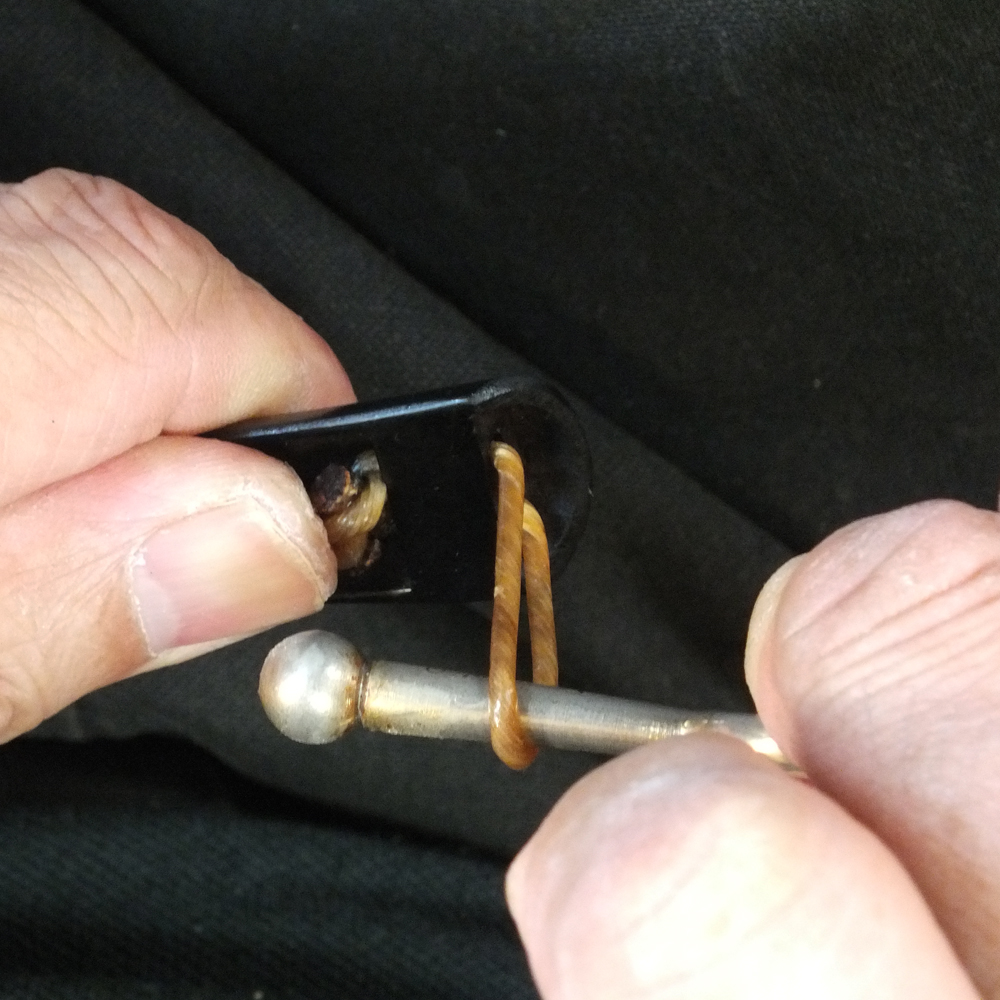
私はこれを避ける為に 不要になった音叉を利用して締め込みをして、最後に本結びがゆるまないように そっと曲げて仮組準備を終わります。
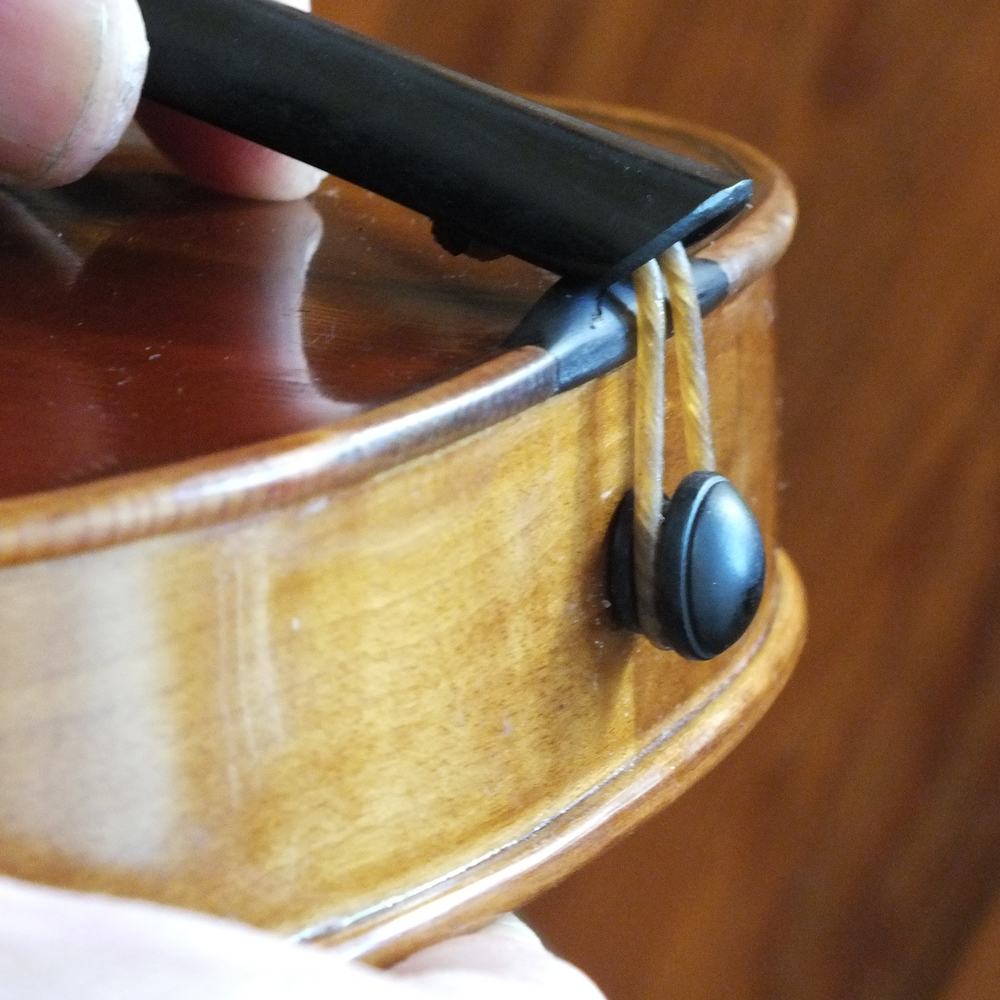
さて、テールガットをエンドピンに架けてみます。私は このテールガットを ( A ) の距離が 52.0mm となるように作業を進めていますが、この段階で駒とテールピースの距離は 54.5mmくらいでした。
8. 最終締め込み工程
さて、いよいよ本結びの仕上がりが見えて来ました。
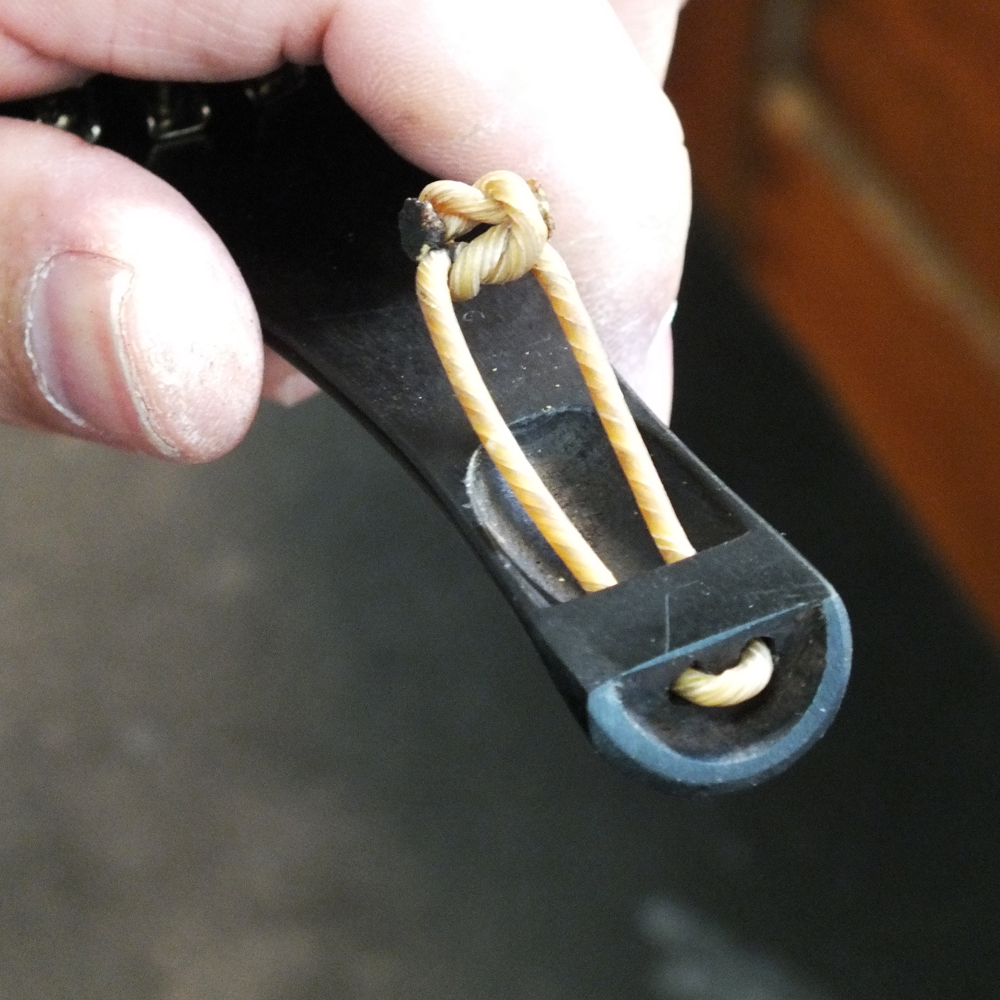
この工程は指の中の作業なので やはり写真では確認しにくいと思います。とにかく、丁寧にもみ込んだりつまんで引っ張ったり、押し込んだり‥ この頃には指がだいぶん痛くなります。
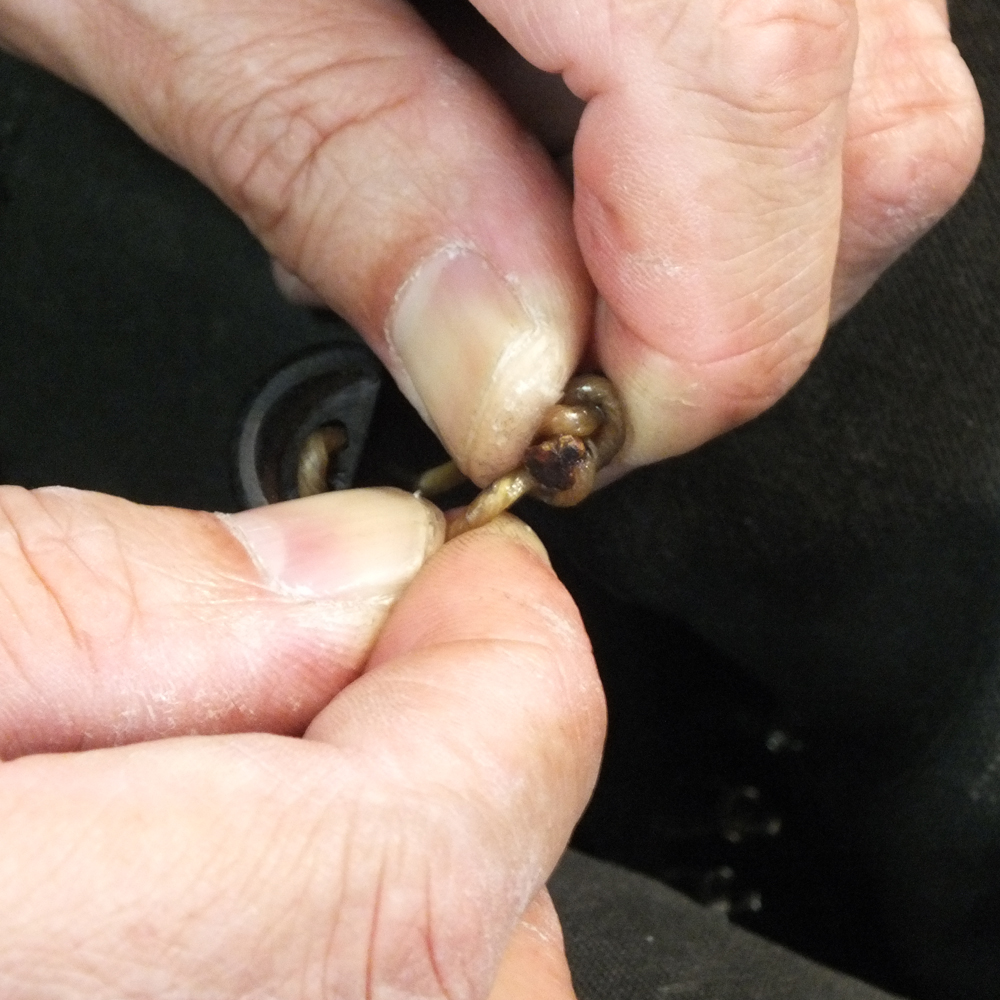
ところで 私が なぜ締め込みにこだわるかと言うと、このタイプのヴァイオリンでは 楽器がゆれ続ける条件として テールピースがエンドブロック部を強くゆらす必要があると考えているからです。
このことから、私は『 このヴァイオリン 』では ( A )52.0mm -( B )110.0mm -( C )1.5 ~ 2.0mmでこの条件が達成できると考えました。そして、このテールピースとサドル距離を 1.5 ~ 2.0 mmに設定しようとすると “ギリギリ感”が大切になってきます。
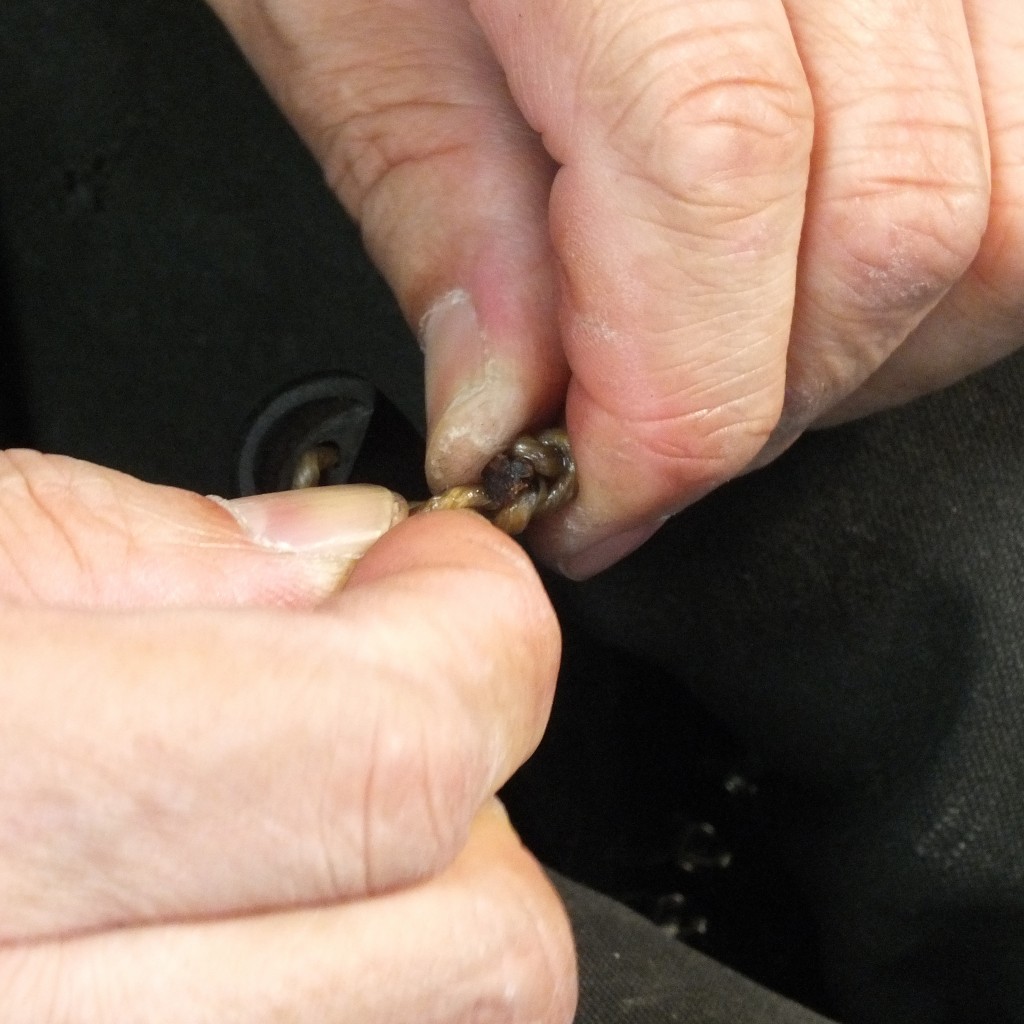
この工程で 私は テールガット長があと 1.0mm 位は 伸びるように締め込みの努力しています。
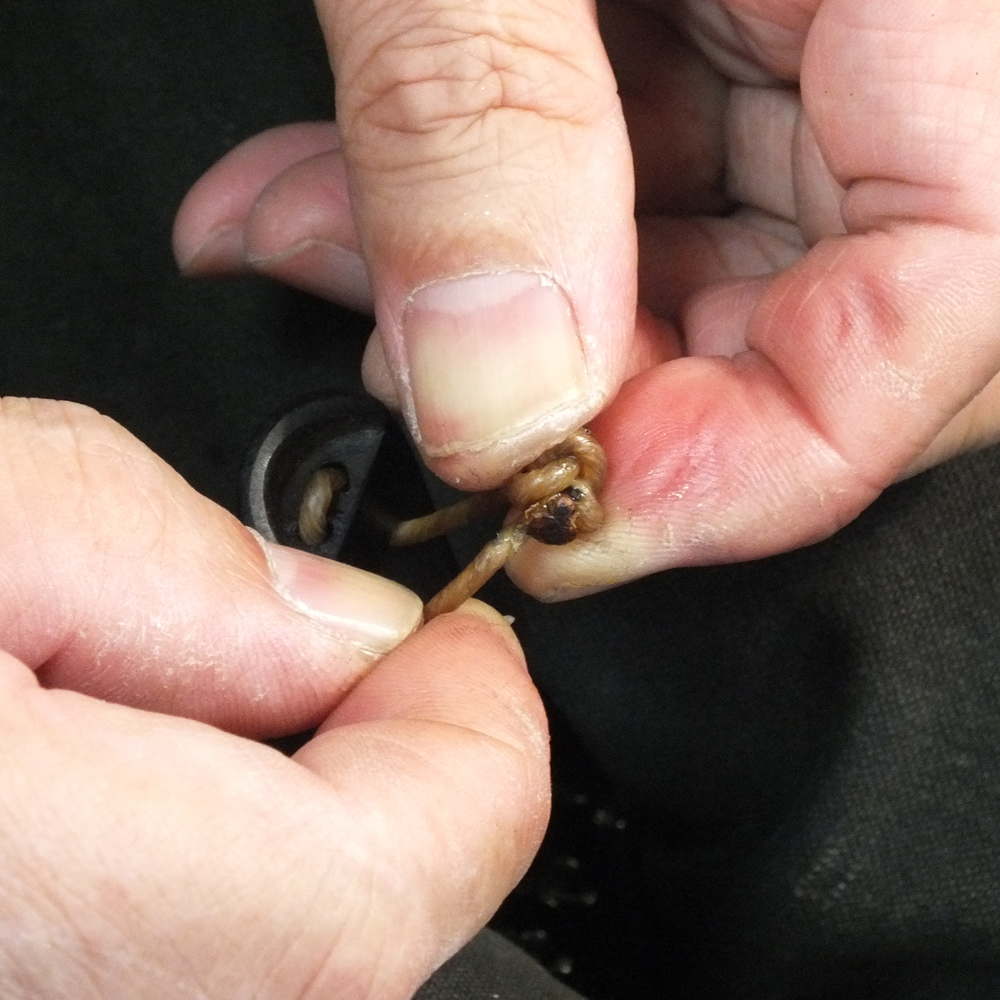
それにしても‥ 人間の指はあまり丈夫ではありません。
この段階になると 私はいつも「 手が‥!手がぁぁ~!!」と叫びたくなったりします。
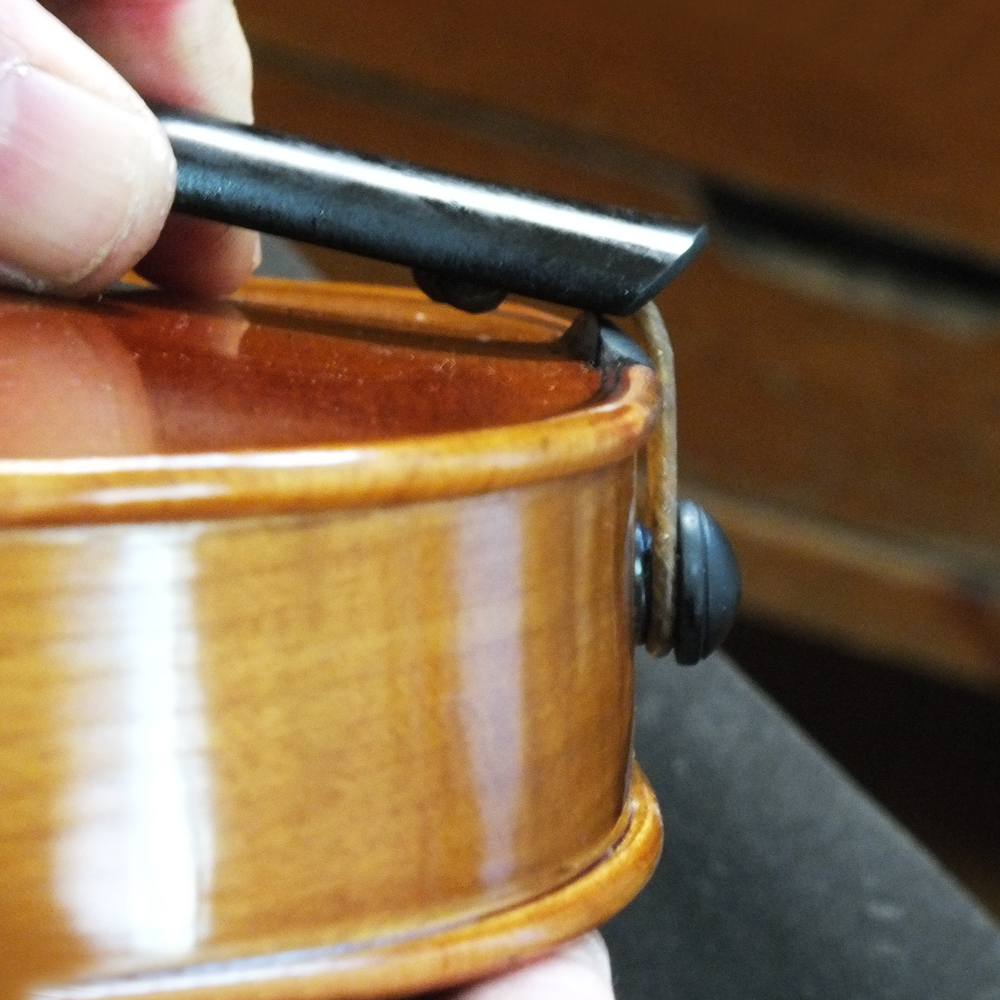
こうして 駒とテールピースの距離は 54.0mm までたどり着きました。
9. 弦張り工程
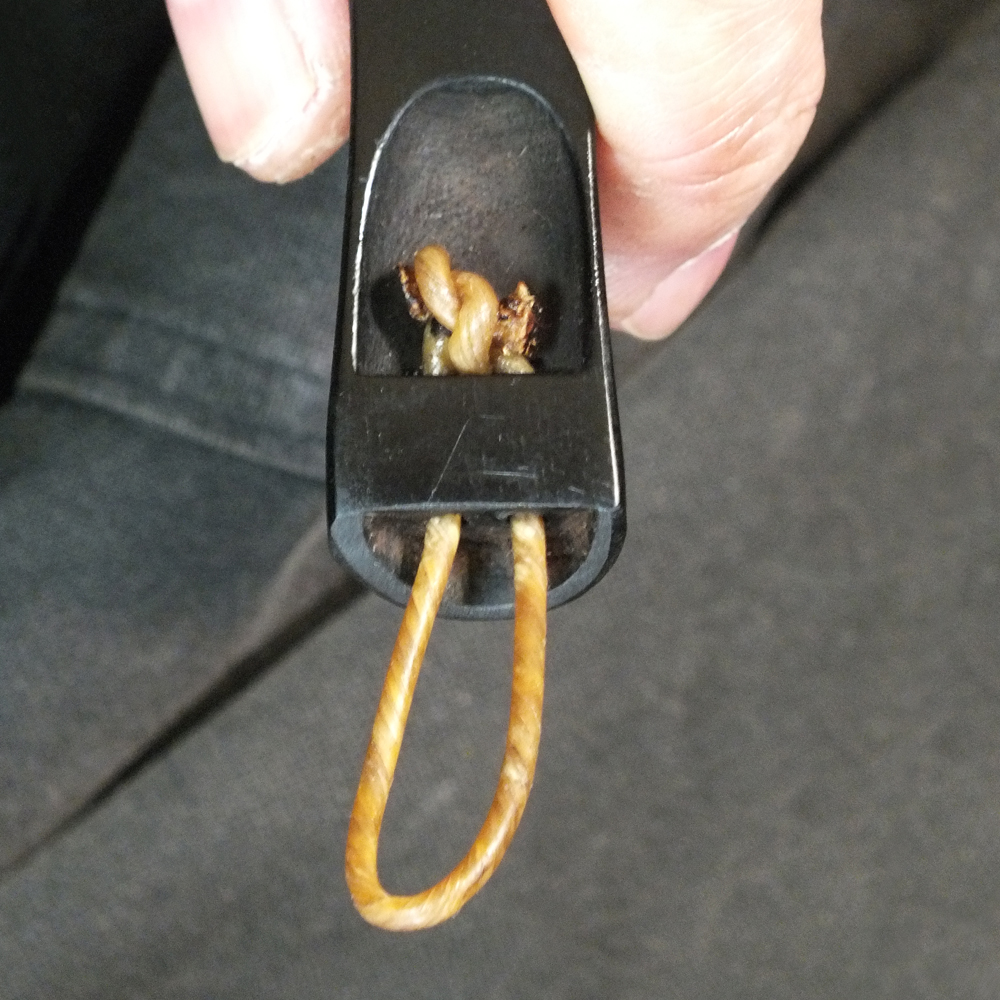
さて、ここまで来るとテールガットの本結び部は こうなっています。
ここから弦を架けますが その際には ガットの本結び部が表板に接触しないように厚紙を折り重ねたものを挿みます。
そして弦の張力を少しづつあげていきます。この時にはサドルの上にテールピースが引っかかったように乗っていますので、テールピースが破損しないように‥すべらせるような感じでおろします。
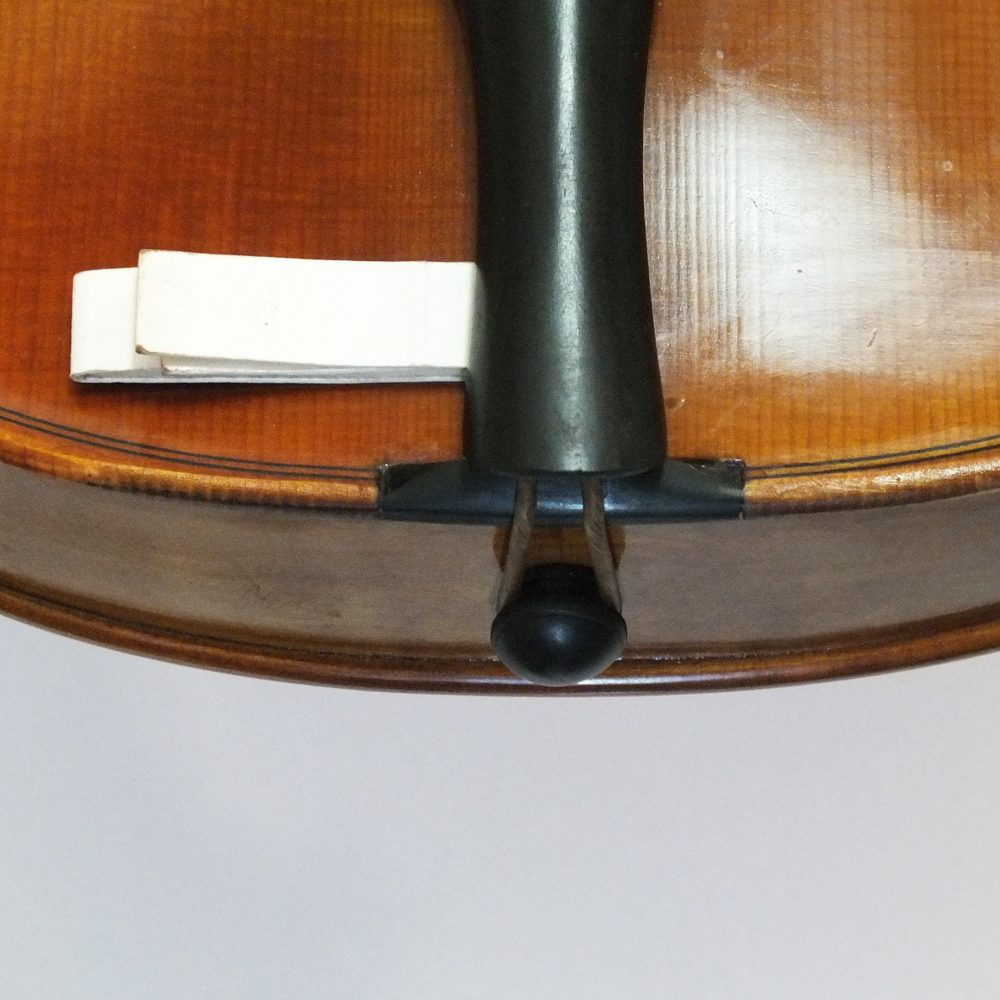
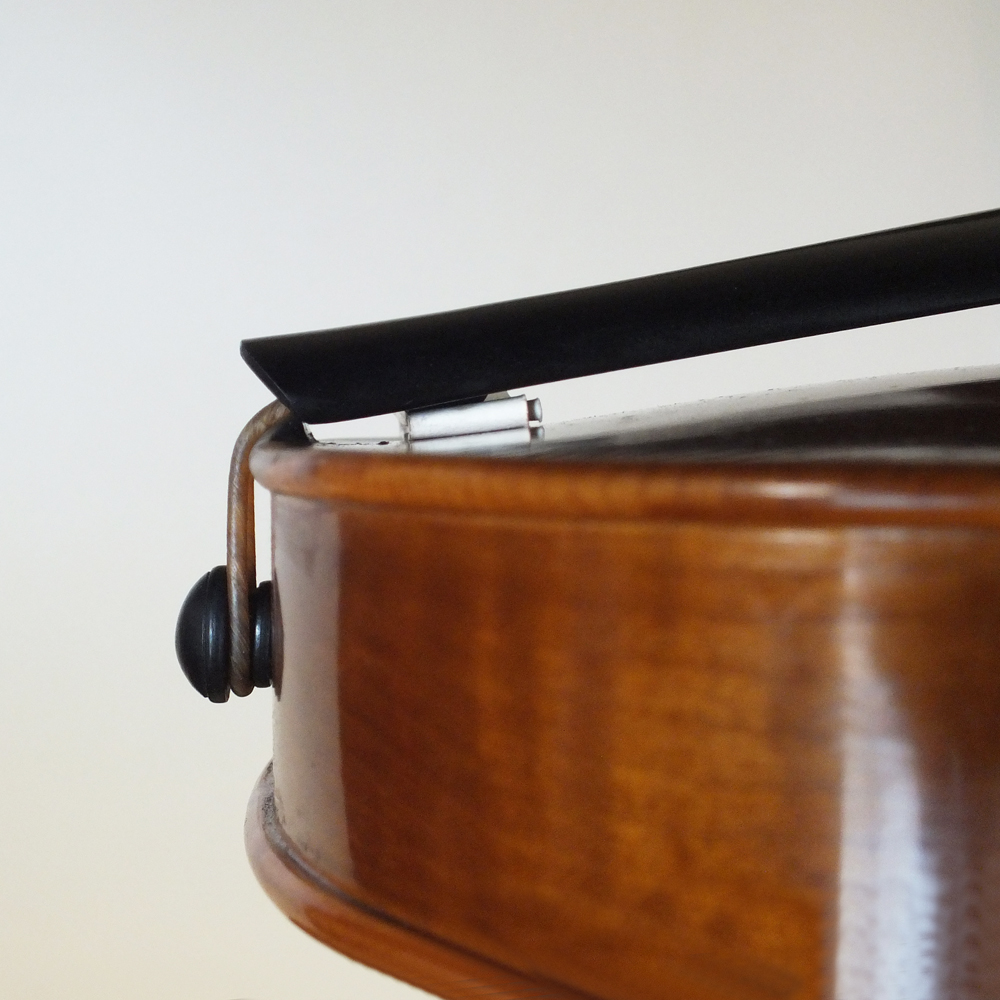
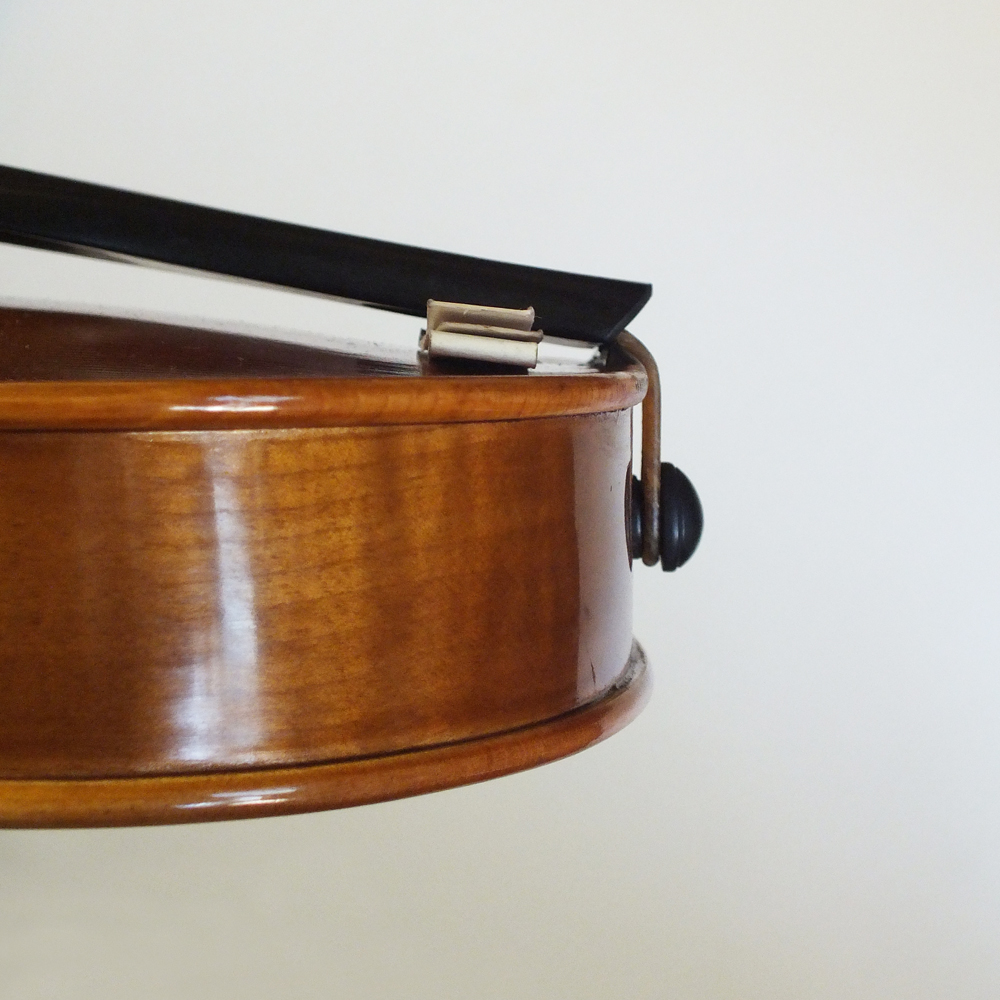
今 ‥ このヴァイオリンの弦はチューニングしてあります。
そして 駒とテールピースの距離は 53.5mm です。
10. 仕上がり
枕を入れた状態で30分ほど工夫をして テールガットの本結びが締め込まれました。
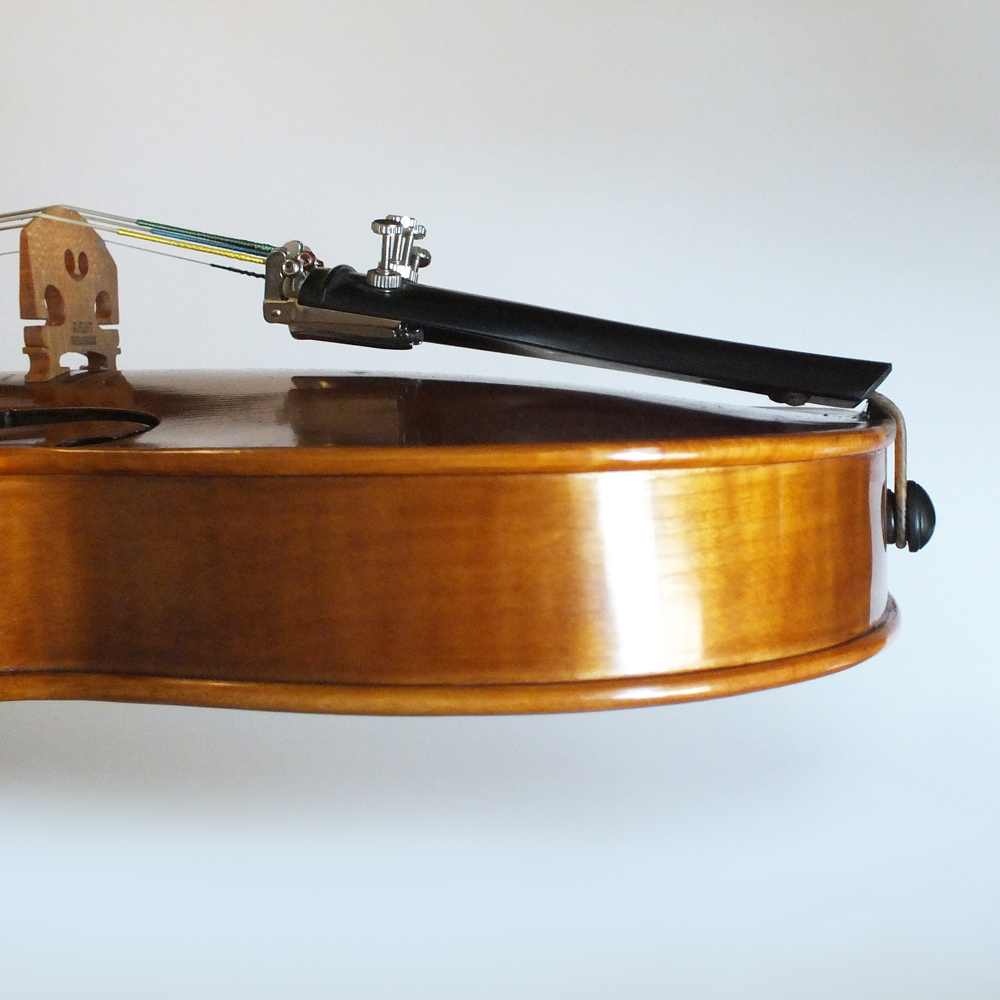
そこで、いよいよ枕を外しました。この段階でサドルとテールピースの間や表板とテールピースの空間がしっかり確保されている事をたしかめます。
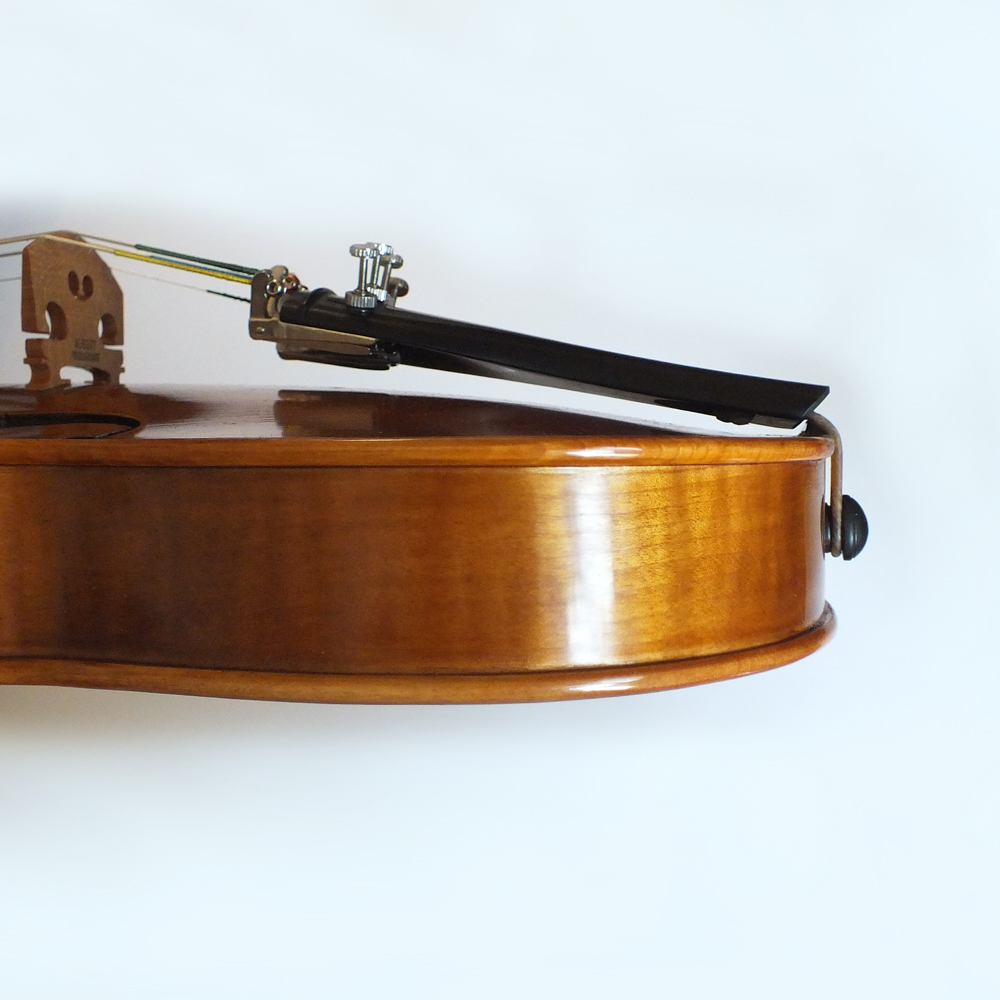
実例としたテールガット取りつけが終了しました。
こうして駒とテールピースの距離は 52.0mm となりました。
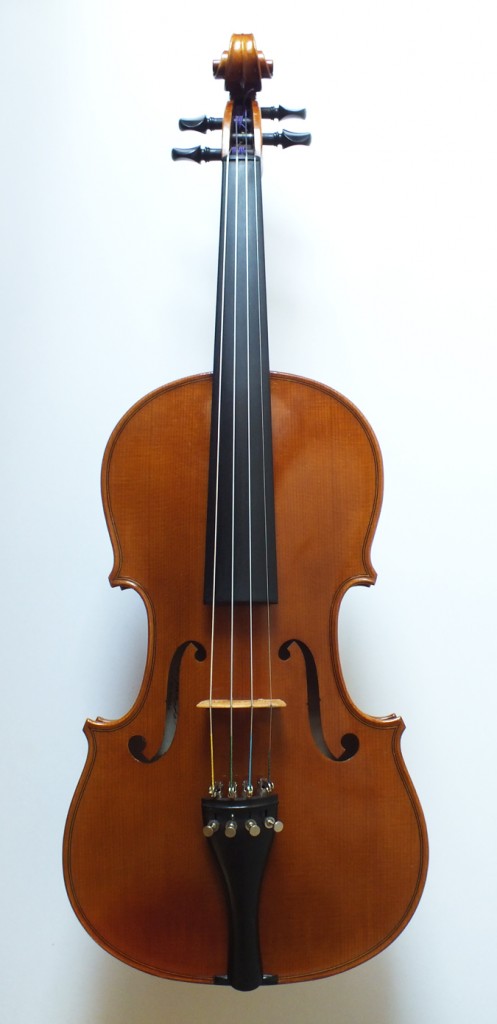
最後になりましたが、今回 参考例とさせていただいた 2004年製の YAMAHA violin にも テールガットは調和していたことをご報告いたします。
16億とはだいぶん違うケタ数の 6万円ほどの このヴァイオリンは響胴が硬い楽器の典型事例のようなものと言えるのではないでしょうか。
アジャスターが 4個取り付けられて初心者に近い方が使用されていますので、私はこのようにしっかり締め込んだ本結びにより 適切なテールガット長として取り付ける事が本当に大切と考えます。
テールガットの取り付け経験が少ない方にとって ガット長の調節が難問でしょうが 、すばらしい響きが持続性をもって設定できると理解されたら 皆さんの判断は速いのでは‥ と 私は思っています。
以上‥ 長文にお付き合い下さって ありがとうございます。
.
.
2017-5-17 Joseph Naomi Yokota
